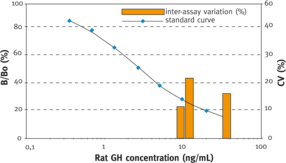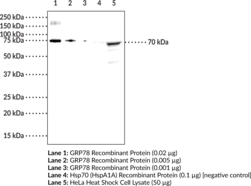Cayman
Showing 22801–22950 of 45550 results
-
GPR120 (free fatty acid receptor 4/FFAR4) is a G protein-coupled receptor expressed in intestine, adipocytes, and pro-inflammatory macrophages that is activated by long-chain free fatty acids. It has been linked to the ability of fatty acids to produce anti-inflammatory effects and to acutely potentiate insulin secretion. Grifolic acid is a selective partial agonist of GPR120 that induces ERK activation and intracellular calcium responses in mouse enteroendocrine STC-1 cells that express GPR120 endogenously, but not those expressing GPR40.{31125}
Brand:CaymanSKU:-Available on backorder
-
Griseofulvin is a natural bacterial product used, in certain formulations, as an oral antibiotic for fungal infections of the skin.{31420} It alters microtubule dynamics, resulting in metaphase arrest.{31421} Antimicrotubule agents, including griseofulvin, have potential applications in cancer therapy, particularly when combined with other chemotherapeutic compounds.{31422,31419}
Brand:CaymanSKU:-Available on backorder
-
Griseofulvin is a natural bacterial product used, in certain formulations, as an oral antibiotic for fungal infections of the skin.{31420} It alters microtubule dynamics, resulting in metaphase arrest.{31421} Antimicrotubule agents, including griseofulvin, have potential applications in cancer therapy, particularly when combined with other chemotherapeutic compounds.{31422,31419}
Brand:CaymanSKU:-Available on backorder
-
Griseofulvin is a natural bacterial product used, in certain formulations, as an oral antibiotic for fungal infections of the skin.{31420} It alters microtubule dynamics, resulting in metaphase arrest.{31421} Antimicrotubule agents, including griseofulvin, have potential applications in cancer therapy, particularly when combined with other chemotherapeutic compounds.{31422,31419}
Brand:CaymanSKU:-Available on backorder
-
GH is a polypeptide hormone with a molecular weight of 23 kDa released from somatotropes of the anterior pituitary. It is regulated by several neurotransmitters and neuropeptides. Among other functions it plays an essential role in regulating body growth. Plasma GH levels in humans are markedly elevated in the perinatal period, in the range of 50 ng/ml, but decline to near-adult levels of 0.5-1.0 ng/ml within a few weeks. GH levels are slightly higher in women than in men, and are increased in both sexes in response to exercise. [Bertin Catalog No. A05104]
Brand:CaymanSKU:589601 - 96 wellsAvailable on backorder
-
Brand:CaymanSKU:32755 - 25 µL
Available on backorder
-
Brand:CaymanSKU:32755- 25 µL
Available on backorder
-
Brand:CaymanSKU:32755- 25 µL
-
Glucose-regulated protein 78 kDa (GRP78), also known as heat shock 70 kDa protein 5 (HspA5) and immunoglobulin heavy chain-binding protein (BiP), is a glucose-regulated protein that is constitutively expressed in the lumen of the endoplasmic reticulum (ER).{36130,36131,36132} It is composed of two functional domains, an N-terminal nucleotide-binding domain that contains an ATP catalytic site and a C-terminal substrate binding domain that binds hydrophobic polypeptides.{36134} GRP78 functions as a molecular chaperone, assisting in the translocation of polypeptides from the cytosol into the ER, folding of nascent polypeptides, as well as refolding and preventing aggregation of misfolded proteins. It also plays a role in the ER-assisted degradation (ERAD) and unfolded protein response (UPR) pathways.{36137,36136} GRP78 chaperone activity is driven by an ATPase cycle that is regulated by ER-localized DnaJ-like protein co-factors and nuclear exchange factors.{36133,36135} Expression of GRP78 is upregulated in response to ER stress caused by viral and bacterial infections as well as various cancers.{36139} ER stress can also promote extracellular secretion of GRP78 leading to its anti-inflammatory functions in immunity.{36138} Cayman’s GRP78 Monoclonal Antibody can be used for Western blot and ELISA applications. The antibody recognizes GRP78 at ~72 kDa from human, mouse, and rat samples.
Brand:CaymanSKU:25690 - 100 µgAvailable on backorder
-
Immunogen: Full length human recombinant GRP78 protein • Host: Mouse • Species reactivity: (+) Human, Mouse, Rat • Cross reactivity: (-) Hsp70 • Applications: ELISA,IHC, WB
Brand:CaymanSKU:25690- 100 µgAvailable on backorder
-
Immunogen: Full length human recombinant GRP78 protein • Host: Mouse • Species reactivity: (+) Human, Mouse, Rat • Cross reactivity: (-) Hsp70 • Applications: ELISA,IHC, WB
Brand:CaymanSKU:25690- 100 µg -
Glucose-regulated protein 78 kDa (GRP78), also known as heat shock 70 kDa protein 5 (HspA5) and immunoglobulin heavy chain-binding protein (BiP), is a glucose-regulated protein that is constitutively expressed in the lumen of the endoplasmic reticulum (ER).{36130,36131,36132} It is composed of two functional domains, an N-terminal nucleotide-binding domain that contains an ATP catalytic site and a C-terminal substrate binding domain that binds hydrophobic polypeptides.{36134} GRP78 functions as a molecular chaperone, assisting in the translocation of polypeptides from the cytosol into the ER, folding of nascent polypeptides, as well as refolding and preventing aggregation of misfolded proteins. It also plays a role in the ER-assisted degradation (ERAD) and unfolded protein response (UPR) pathways.{36137,36136} GRP78 chaperone activity is driven by an ATPase cycle that is regulated by ER-localized DnaJ-like protein co-factors and nuclear exchange factors.{36133,36135} Expression of GRP78 is upregulated in response to ER stress caused by viral and bacterial infections as well as various cancers.{36139} ER stress can also promote extracellular secretion of GRP78 leading to its anti-inflammatory functions in immunity.{36138} Cayman’s GRP78 Polyclonal Antibody can be used for Western blot and ELISA applications. The antibody recognizes GRP78 at ~72 kDa from human samples.
Brand:CaymanSKU:24533 - 500 µgAvailable on backorder
-
Immunogen: Human recombinant GRP78 protein (full length) • Host: Rabbit • Species reactivity: (+) Human • Applications: ELISA, IHC, WB
Brand:CaymanSKU:24533- 500 µgAvailable on backorder
-
Immunogen: Human recombinant GRP78 protein (full length) • Host: Rabbit • Species reactivity: (+) Human • Applications: ELISA, IHC, WB
Brand:CaymanSKU:24533- 500 µg -
Immunogen: Purified GRP94 isolated from chicken oviducts · Host: rat, clone 9G10 · Species Reactivity: (+) Human, African clawed frog (X. laevis), bovine, chicken, dog, guinea pig (C. porcellus), hamster, horse, monkey, mouse, pig, rabbit, rat, and sheep GPR94 · Applications: FC, ICC/IF, IP, and WB · Isotype: IgG2a
Brand:CaymanSKU:10011424- 200 µg -
Glucose regulated protein 94 (GRP94) is a constitutively expressed endoplasmic reticulum (ER) lumenal protein that is up-regulated in response to cellular stress such as heat shock, oxidative stress or glucose depletion. GRP94 is thought to play a role in protein translocation to the ER, in their subsequent folding and assembly, and in regulating protein secretion.{15669} GRP94 also plays a role in antigen presentation by accessing the endogenous pathway and eliciting specific cytotoxic T lymphocyte (CTL) responses to chaperone bound peptides via the major histocompatibility complex (MHC) class I pathway.{15670} GRP94 is a member of the Hsp90 family of stress proteins and shares sequence homology with its cytosolic equivalent, Hsp90.{15671} Both Hsp90 and GRP94 are calcium binding proteins.{15672} Despite sharing 50% sequence homology over its N domains and complete conservation in its ligand binding domains with Hsp90, GRP94, and Hsp90 differ in their interactions with regulatory ligands as GRP94 has weak ATP binding and hydrolysis activity.{15673} GRP94 exists as a homodimer and the two subunits interact at two distinct intermolecular sites, C-terminal dimerization domains and the N-terminal interacts with the middle domain of opposing subunits.{15674} GRP94 contains a carboxy terminal KDEL (Lys-Asp-Glu-Leu) sequence which is believed to aid in its retention in the ER.{15675}
Brand:CaymanSKU:10011424 - 200 µgAvailable on backorder
-
Immunogen: Purified GRP94 isolated from chicken oviducts · Host: rat, clone 9G10 · Species Reactivity: (+) Human, African clawed frog (X. laevis), bovine, chicken, dog, guinea pig (C. porcellus), hamster, horse, monkey, mouse, pig, rabbit, rat, and sheep GPR94 · Applications: FC, ICC/IF, IP, and WB · Isotype: IgG2a
Brand:CaymanSKU:10011424- 200 µgAvailable on backorder
-
Immunogen: Purified GRP94 isolated from chicken oviducts · Host: rat, clone 9G10 · Species Reactivity: (+) Human, African clawed frog (X. laevis), bovine, chicken, dog, guinea pig (C. porcellus), hamster, horse, monkey, mouse, pig, rabbit, rat, and sheep GPR94 · Applications: FC, ICC/IF, IP, and WB · Isotype: IgG2a
Brand:CaymanSKU:10011424- 50 µg -
Glucose regulated protein 94 (GRP94) is a constitutively expressed endoplasmic reticulum (ER) lumenal protein that is up-regulated in response to cellular stress such as heat shock, oxidative stress or glucose depletion. GRP94 is thought to play a role in protein translocation to the ER, in their subsequent folding and assembly, and in regulating protein secretion.{15669} GRP94 also plays a role in antigen presentation by accessing the endogenous pathway and eliciting specific cytotoxic T lymphocyte (CTL) responses to chaperone bound peptides via the major histocompatibility complex (MHC) class I pathway.{15670} GRP94 is a member of the Hsp90 family of stress proteins and shares sequence homology with its cytosolic equivalent, Hsp90.{15671} Both Hsp90 and GRP94 are calcium binding proteins.{15672} Despite sharing 50% sequence homology over its N domains and complete conservation in its ligand binding domains with Hsp90, GRP94, and Hsp90 differ in their interactions with regulatory ligands as GRP94 has weak ATP binding and hydrolysis activity.{15673} GRP94 exists as a homodimer and the two subunits interact at two distinct intermolecular sites, C-terminal dimerization domains and the N-terminal interacts with the middle domain of opposing subunits.{15674} GRP94 contains a carboxy terminal KDEL (Lys-Asp-Glu-Leu) sequence which is believed to aid in its retention in the ER.{15675}
Brand:CaymanSKU:10011424 - 50 µgAvailable on backorder
-
Immunogen: Purified GRP94 isolated from chicken oviducts · Host: rat, clone 9G10 · Species Reactivity: (+) Human, African clawed frog (X. laevis), bovine, chicken, dog, guinea pig (C. porcellus), hamster, horse, monkey, mouse, pig, rabbit, rat, and sheep GPR94 · Applications: FC, ICC/IF, IP, and WB · Isotype: IgG2a
Brand:CaymanSKU:10011424- 50 µgAvailable on backorder
-
GS-143 is an inhibitor of IκBα ubiquitylation.{45272} It inhibits ubiquitylation of phosphorylated IκBα mediated by the SCFβTrCP1 E3 ubiquitin ligase complex in vitro (IC50 = 5.2 μM) and reduces TNF-α-induced degradation of phosphorylated IκBα, but not β-catenin, another SCFβTrCP1 substrate, in HeLa S3 cells. GS-143 inhibits LPS-induced expression of TNF-α, IL-6, IL-12, ICAM-1, and NF-κB in THP-1 cells in a concentration-dependent manner. Intranasal administration of GS-143 (32 μg/animal) reduces the number of eosinophils, lymphocytes, and total cells in bronchoalveolar lavage fluid (BALF) in an ovalbumin-sensitized mouse model of allergic asthma.{45273}
Brand:CaymanSKU:26138 - 10 mgAvailable on backorder
-
GS-143 is an inhibitor of IκBα ubiquitylation.{45272} It inhibits ubiquitylation of phosphorylated IκBα mediated by the SCFβTrCP1 E3 ubiquitin ligase complex in vitro (IC50 = 5.2 μM) and reduces TNF-α-induced degradation of phosphorylated IκBα, but not β-catenin, another SCFβTrCP1 substrate, in HeLa S3 cells. GS-143 inhibits LPS-induced expression of TNF-α, IL-6, IL-12, ICAM-1, and NF-κB in THP-1 cells in a concentration-dependent manner. Intranasal administration of GS-143 (32 μg/animal) reduces the number of eosinophils, lymphocytes, and total cells in bronchoalveolar lavage fluid (BALF) in an ovalbumin-sensitized mouse model of allergic asthma.{45273}
Brand:CaymanSKU:26138 - 25 mgAvailable on backorder
-
GS-143 is an inhibitor of IκBα ubiquitylation.{45272} It inhibits ubiquitylation of phosphorylated IκBα mediated by the SCFβTrCP1 E3 ubiquitin ligase complex in vitro (IC50 = 5.2 μM) and reduces TNF-α-induced degradation of phosphorylated IκBα, but not β-catenin, another SCFβTrCP1 substrate, in HeLa S3 cells. GS-143 inhibits LPS-induced expression of TNF-α, IL-6, IL-12, ICAM-1, and NF-κB in THP-1 cells in a concentration-dependent manner. Intranasal administration of GS-143 (32 μg/animal) reduces the number of eosinophils, lymphocytes, and total cells in bronchoalveolar lavage fluid (BALF) in an ovalbumin-sensitized mouse model of allergic asthma.{45273}
Brand:CaymanSKU:26138 - 5 mgAvailable on backorder
-
GS-143 is an inhibitor of IκBα ubiquitylation.{45272} It inhibits ubiquitylation of phosphorylated IκBα mediated by the SCFβTrCP1 E3 ubiquitin ligase complex in vitro (IC50 = 5.2 μM) and reduces TNF-α-induced degradation of phosphorylated IκBα, but not β-catenin, another SCFβTrCP1 substrate, in HeLa S3 cells. GS-143 inhibits LPS-induced expression of TNF-α, IL-6, IL-12, ICAM-1, and NF-κB in THP-1 cells in a concentration-dependent manner. Intranasal administration of GS-143 (32 μg/animal) reduces the number of eosinophils, lymphocytes, and total cells in bronchoalveolar lavage fluid (BALF) in an ovalbumin-sensitized mouse model of allergic asthma.{45273}
Brand:CaymanSKU:26138 - 50 mgAvailable on backorder
-
GS-39783 is a positive allosteric modulator of GABAB receptors that potentiates GABA-stimulated [35S]GTPγS binding to recombinant human GABAB receptors and rat cortical membranes (EC50s = 2.1 and 3.1 μM, respectively).{53122} It amplifies GABAB receptor-mediated transient calcium signaling in HEK293 cells expressing human receptors (EC50 = 2.4 μM). GS-39783 (25-100 mg/kg) suppresses alcohol self-administration, but has no effect on lever-responding for food, in Indiana alcohol-preferring, Sardinian alcohol-preferring, and Alko Alcohol rats.{53123} It reduces amphetamine- or MK-801-induced hyperactivity in rats and the number of DOI-induced head twitches in mice, indicating antipsychotic-like activity.{53124} GS-39783 also reduces the incidence of sound-induced tonic convulsions in juvenile mice (ED50 = 55.38 mg/kg).{53125}
Brand:CaymanSKU:29482 - 10 mgAvailable on backorder
-
GS-39783 is a positive allosteric modulator of GABAB receptors that potentiates GABA-stimulated [35S]GTPγS binding to recombinant human GABAB receptors and rat cortical membranes (EC50s = 2.1 and 3.1 μM, respectively).{53122} It amplifies GABAB receptor-mediated transient calcium signaling in HEK293 cells expressing human receptors (EC50 = 2.4 μM). GS-39783 (25-100 mg/kg) suppresses alcohol self-administration, but has no effect on lever-responding for food, in Indiana alcohol-preferring, Sardinian alcohol-preferring, and Alko Alcohol rats.{53123} It reduces amphetamine- or MK-801-induced hyperactivity in rats and the number of DOI-induced head twitches in mice, indicating antipsychotic-like activity.{53124} GS-39783 also reduces the incidence of sound-induced tonic convulsions in juvenile mice (ED50 = 55.38 mg/kg).{53125}
Brand:CaymanSKU:29482 - 25 mgAvailable on backorder
-
GS-39783 is a positive allosteric modulator of GABAB receptors that potentiates GABA-stimulated [35S]GTPγS binding to recombinant human GABAB receptors and rat cortical membranes (EC50s = 2.1 and 3.1 μM, respectively).{53122} It amplifies GABAB receptor-mediated transient calcium signaling in HEK293 cells expressing human receptors (EC50 = 2.4 μM). GS-39783 (25-100 mg/kg) suppresses alcohol self-administration, but has no effect on lever-responding for food, in Indiana alcohol-preferring, Sardinian alcohol-preferring, and Alko Alcohol rats.{53123} It reduces amphetamine- or MK-801-induced hyperactivity in rats and the number of DOI-induced head twitches in mice, indicating antipsychotic-like activity.{53124} GS-39783 also reduces the incidence of sound-induced tonic convulsions in juvenile mice (ED50 = 55.38 mg/kg).{53125}
Brand:CaymanSKU:29482 - 5 mgAvailable on backorder
-
GS-39783 is a positive allosteric modulator of GABAB receptors that potentiates GABA-stimulated [35S]GTPγS binding to recombinant human GABAB receptors and rat cortical membranes (EC50s = 2.1 and 3.1 μM, respectively).{53122} It amplifies GABAB receptor-mediated transient calcium signaling in HEK293 cells expressing human receptors (EC50 = 2.4 μM). GS-39783 (25-100 mg/kg) suppresses alcohol self-administration, but has no effect on lever-responding for food, in Indiana alcohol-preferring, Sardinian alcohol-preferring, and Alko Alcohol rats.{53123} It reduces amphetamine- or MK-801-induced hyperactivity in rats and the number of DOI-induced head twitches in mice, indicating antipsychotic-like activity.{53124} GS-39783 also reduces the incidence of sound-induced tonic convulsions in juvenile mice (ED50 = 55.38 mg/kg).{53125}
Brand:CaymanSKU:29482 - 50 mgAvailable on backorder
-
GS-441524 is an antiviral nucleoside analog and a metabolite of remdesivir (Item No. 30354).{45842} Upon entry into cells, GS-441524 is metabolized to an active triphosphate form that induces RNA chain termination and inhibits viral polymerases. It is active against Middle East respiratory syndrome coronavirus (MERS-CoV) and severe acute respiratory syndrome CoV (SARS-CoV) in infected primary human airway epithelial (HAE) cells (EC50s = 0.86 and 0.18 µM, respectively). GS-441524 reduces viral plaque formation in SARS-CoV-2-infected Vero E6 and Calu-3 2B4 cells (EC50s = 0.42 and 0.62 mM, respectively).{61140} It is cytoprotective against hepatitis C virus (HCV), yellow fever virus (YFV), dengue virus type 2 (DENV-2), influenza A, and parainfluenza 3 in cell-based assays (EC50s = 4.1, 11, 9.46, 27.9, and 1.71 µM, respectively).{53439}
Brand:CaymanSKU:30469 - 1 mgAvailable on backorder
-
GS-441524 is an antiviral nucleoside analog and a metabolite of remdesivir (Item No. 30354).{45842} Upon entry into cells, GS-441524 is metabolized to an active triphosphate form that induces RNA chain termination and inhibits viral polymerases. It is active against Middle East respiratory syndrome coronavirus (MERS-CoV) and severe acute respiratory syndrome CoV (SARS-CoV) in infected primary human airway epithelial (HAE) cells (EC50s = 0.86 and 0.18 µM, respectively). GS-441524 reduces viral plaque formation in SARS-CoV-2-infected Vero E6 and Calu-3 2B4 cells (EC50s = 0.42 and 0.62 mM, respectively).{61140} It is cytoprotective against hepatitis C virus (HCV), yellow fever virus (YFV), dengue virus type 2 (DENV-2), influenza A, and parainfluenza 3 in cell-based assays (EC50s = 4.1, 11, 9.46, 27.9, and 1.71 µM, respectively).{53439}
Brand:CaymanSKU:30469 - 10 mgAvailable on backorder
-
GS-441524 is an antiviral nucleoside analog and a metabolite of remdesivir (Item No. 30354).{45842} Upon entry into cells, GS-441524 is metabolized to an active triphosphate form that induces RNA chain termination and inhibits viral polymerases. It is active against Middle East respiratory syndrome coronavirus (MERS-CoV) and severe acute respiratory syndrome CoV (SARS-CoV) in infected primary human airway epithelial (HAE) cells (EC50s = 0.86 and 0.18 µM, respectively). GS-441524 reduces viral plaque formation in SARS-CoV-2-infected Vero E6 and Calu-3 2B4 cells (EC50s = 0.42 and 0.62 mM, respectively).{61140} It is cytoprotective against hepatitis C virus (HCV), yellow fever virus (YFV), dengue virus type 2 (DENV-2), influenza A, and parainfluenza 3 in cell-based assays (EC50s = 4.1, 11, 9.46, 27.9, and 1.71 µM, respectively).{53439}
Brand:CaymanSKU:30469 - 25 mgAvailable on backorder
-
GS-441524 is an antiviral nucleoside analog and a metabolite of remdesivir (Item No. 30354).{45842} Upon entry into cells, GS-441524 is metabolized to an active triphosphate form that induces RNA chain termination and inhibits viral polymerases. It is active against Middle East respiratory syndrome coronavirus (MERS-CoV) and severe acute respiratory syndrome CoV (SARS-CoV) in infected primary human airway epithelial (HAE) cells (EC50s = 0.86 and 0.18 µM, respectively). GS-441524 reduces viral plaque formation in SARS-CoV-2-infected Vero E6 and Calu-3 2B4 cells (EC50s = 0.42 and 0.62 mM, respectively).{61140} It is cytoprotective against hepatitis C virus (HCV), yellow fever virus (YFV), dengue virus type 2 (DENV-2), influenza A, and parainfluenza 3 in cell-based assays (EC50s = 4.1, 11, 9.46, 27.9, and 1.71 µM, respectively).{53439}
Brand:CaymanSKU:30469 - 5 mgAvailable on backorder
-
Brand:CaymanSKU:9003635 - 1 mg
Available on backorder
-
Brand:CaymanSKU:9003635 - 5 mg
Available on backorder
-
GS-704277 is an intermediate alanine metabolite of the antiviral prodrug remdesivir (Item No. 30354).{52858,52859} It is formed from remdesivir via intracellular hydrolysis. GS-704277 is further metabolized to the nucleoside monophosphate form and then to the nucleoside analog GS-441524 (Item No. 30469) or active nucleoside triphosphate GS-443902.
Brand:CaymanSKU:9003569 - 1 mgAvailable on backorder
-
GS-704277 is an intermediate alanine metabolite of the antiviral prodrug remdesivir (Item No. 30354).{52858,52859} It is formed from remdesivir via intracellular hydrolysis. GS-704277 is further metabolized to the nucleoside monophosphate form and then to the nucleoside analog GS-441524 (Item No. 30469) or active nucleoside triphosphate GS-443902.
Brand:CaymanSKU:9003569 - 500 µgAvailable on backorder
-
GS-7340 is a prodrug form of the antiviral adenosine analog tenofovir (Item No. 13874).{42639} It reduces HIV-1 viral replication in MT-2 cells with an EC50 value of 5 nM.
Brand:CaymanSKU:26214 - 10 mgAvailable on backorder
-
GS-7340 is a prodrug form of the antiviral adenosine analog tenofovir (Item No. 13874).{42639} It reduces HIV-1 viral replication in MT-2 cells with an EC50 value of 5 nM.
Brand:CaymanSKU:26214 - 100 mgAvailable on backorder
-
GS-7340 is a prodrug form of the antiviral adenosine analog tenofovir (Item No. 13874).{42639} It reduces HIV-1 viral replication in MT-2 cells with an EC50 value of 5 nM.
Brand:CaymanSKU:26214 - 5 mgAvailable on backorder
-
GS-7340 is a prodrug form of the antiviral adenosine analog tenofovir (Item No. 13874).{42639} It reduces HIV-1 viral replication in MT-2 cells with an EC50 value of 5 nM.
Brand:CaymanSKU:26214 - 50 mgAvailable on backorder
-
GS-9620 is an orally available agonist of toll-like receptor 7 (TLR7; EC50 = 291 nM) with 30-fold selectivity over TLR8 (EC50 = 9 µM).{32637} It has been shown to stimulate a TLR7 immune response in two different animal models of chronic hepatitis B infection and to inhibit HIV-1 infection in human peripheral blood mononuclear cells.{32636,32635,32634}
Brand:CaymanSKU:19628 -Available on backorder
-
GS-9620 is an orally available agonist of toll-like receptor 7 (TLR7; EC50 = 291 nM) with 30-fold selectivity over TLR8 (EC50 = 9 µM).{32637} It has been shown to stimulate a TLR7 immune response in two different animal models of chronic hepatitis B infection and to inhibit HIV-1 infection in human peripheral blood mononuclear cells.{32636,32635,32634}
Brand:CaymanSKU:19628 -Available on backorder
-
GS-9620 is an orally available agonist of toll-like receptor 7 (TLR7; EC50 = 291 nM) with 30-fold selectivity over TLR8 (EC50 = 9 µM).{32637} It has been shown to stimulate a TLR7 immune response in two different animal models of chronic hepatitis B infection and to inhibit HIV-1 infection in human peripheral blood mononuclear cells.{32636,32635,32634}
Brand:CaymanSKU:19628 -Available on backorder
-
GS-9620 is an orally available agonist of toll-like receptor 7 (TLR7; EC50 = 291 nM) with 30-fold selectivity over TLR8 (EC50 = 9 µM).{32637} It has been shown to stimulate a TLR7 immune response in two different animal models of chronic hepatitis B infection and to inhibit HIV-1 infection in human peripheral blood mononuclear cells.{32636,32635,32634}
Brand:CaymanSKU:19628 -Available on backorder
-
Spleen tyrosine kinase (Syk) is a non-receptor tyrosine kinase that upon phosphorylation binds to immunoreceptor tyrosine-based activation motifs of FcRγ chains and mediates downstream signaling related to platelet function and inflammation.{24052} GS-9973 is a potent Syk inhibitor (IC50 = 7.7 nM) that demonstrates 10-35-fold selectivity for Syk over a panel of 359 nonmutant kinases.{28699} In conjunction with the PI3Kδ inhibitor CAL-101 (Item No. 15279), it has been used to reduce chronic lymphocytic leukemia cell survival and to disrupt chemokine signaling at nanomolar concentrations.{28700}
Brand:CaymanSKU:-Available on backorder
-
Spleen tyrosine kinase (Syk) is a non-receptor tyrosine kinase that upon phosphorylation binds to immunoreceptor tyrosine-based activation motifs of FcRγ chains and mediates downstream signaling related to platelet function and inflammation.{24052} GS-9973 is a potent Syk inhibitor (IC50 = 7.7 nM) that demonstrates 10-35-fold selectivity for Syk over a panel of 359 nonmutant kinases.{28699} In conjunction with the PI3Kδ inhibitor CAL-101 (Item No. 15279), it has been used to reduce chronic lymphocytic leukemia cell survival and to disrupt chemokine signaling at nanomolar concentrations.{28700}
Brand:CaymanSKU:-Available on backorder
-
Spleen tyrosine kinase (Syk) is a non-receptor tyrosine kinase that upon phosphorylation binds to immunoreceptor tyrosine-based activation motifs of FcRγ chains and mediates downstream signaling related to platelet function and inflammation.{24052} GS-9973 is a potent Syk inhibitor (IC50 = 7.7 nM) that demonstrates 10-35-fold selectivity for Syk over a panel of 359 nonmutant kinases.{28699} In conjunction with the PI3Kδ inhibitor CAL-101 (Item No. 15279), it has been used to reduce chronic lymphocytic leukemia cell survival and to disrupt chemokine signaling at nanomolar concentrations.{28700}
Brand:CaymanSKU:-Available on backorder
-
Spleen tyrosine kinase (Syk) is a non-receptor tyrosine kinase that upon phosphorylation binds to immunoreceptor tyrosine-based activation motifs of FcRγ chains and mediates downstream signaling related to platelet function and inflammation.{24052} GS-9973 is a potent Syk inhibitor (IC50 = 7.7 nM) that demonstrates 10-35-fold selectivity for Syk over a panel of 359 nonmutant kinases.{28699} In conjunction with the PI3Kδ inhibitor CAL-101 (Item No. 15279), it has been used to reduce chronic lymphocytic leukemia cell survival and to disrupt chemokine signaling at nanomolar concentrations.{28700}
Brand:CaymanSKU:-Available on backorder
-
Inhibition of cardiac late sodium current (late INa) is a strategy to suppress arrhythmias and sodium-dependent calcium overload associated with myocardial ischemia and heart failure. GS967 is a selective inhibitor of late INa that has been shown to suppress experimentally induced arrhythmias in rabbit myocytes and hearts.{30900} It can inhibit A. sulcata toxin II–induced late INa in ventricular myocytes and isolated hearts with IC50 values of 0.13 and 0.21 µM, respectively.{30900} GS967 causes minimal inhibition of the delayed-rectifier potassium current nor does it affect L- or T-type calcium channel currents, sodium-calcium exchanger currents, or a panel of 162 receptors, ion channels, transporters, and enzymes.{30900}
Brand:CaymanSKU:-Available on backorder
-
Inhibition of cardiac late sodium current (late INa) is a strategy to suppress arrhythmias and sodium-dependent calcium overload associated with myocardial ischemia and heart failure. GS967 is a selective inhibitor of late INa that has been shown to suppress experimentally induced arrhythmias in rabbit myocytes and hearts.{30900} It can inhibit A. sulcata toxin II–induced late INa in ventricular myocytes and isolated hearts with IC50 values of 0.13 and 0.21 µM, respectively.{30900} GS967 causes minimal inhibition of the delayed-rectifier potassium current nor does it affect L- or T-type calcium channel currents, sodium-calcium exchanger currents, or a panel of 162 receptors, ion channels, transporters, and enzymes.{30900}
Brand:CaymanSKU:-Available on backorder
-
Inhibition of cardiac late sodium current (late INa) is a strategy to suppress arrhythmias and sodium-dependent calcium overload associated with myocardial ischemia and heart failure. GS967 is a selective inhibitor of late INa that has been shown to suppress experimentally induced arrhythmias in rabbit myocytes and hearts.{30900} It can inhibit A. sulcata toxin II–induced late INa in ventricular myocytes and isolated hearts with IC50 values of 0.13 and 0.21 µM, respectively.{30900} GS967 causes minimal inhibition of the delayed-rectifier potassium current nor does it affect L- or T-type calcium channel currents, sodium-calcium exchanger currents, or a panel of 162 receptors, ion channels, transporters, and enzymes.{30900}
Brand:CaymanSKU:-Available on backorder
-
Smoothened (SMO) is a cell surface receptor that, with Patched, mediates hedgehog signaling to regulate gene expression through the Gli transcription factors.{21774} GSA 10 is a quinolinecarboxamide derivative that acts as an agonist of SMO.{26551} By acting at SMO, GSA 10 has been shown to promote the differentiation of multipotent mesenchymal progenitor cells into osteoblasts (EC50 = 1.2 µM).{26551} Most notably, GSA 10 does not recognize the classic cyclopamine binding site as do other SMO agonists and as such has been used to characterize a novel SMO active site.{26551}
Brand:CaymanSKU:- -
Smoothened (SMO) is a cell surface receptor that, with Patched, mediates hedgehog signaling to regulate gene expression through the Gli transcription factors.{21774} GSA 10 is a quinolinecarboxamide derivative that acts as an agonist of SMO.{26551} By acting at SMO, GSA 10 has been shown to promote the differentiation of multipotent mesenchymal progenitor cells into osteoblasts (EC50 = 1.2 µM).{26551} Most notably, GSA 10 does not recognize the classic cyclopamine binding site as do other SMO agonists and as such has been used to characterize a novel SMO active site.{26551}
Brand:CaymanSKU:- -
Smoothened (SMO) is a cell surface receptor that, with Patched, mediates hedgehog signaling to regulate gene expression through the Gli transcription factors.{21774} GSA 10 is a quinolinecarboxamide derivative that acts as an agonist of SMO.{26551} By acting at SMO, GSA 10 has been shown to promote the differentiation of multipotent mesenchymal progenitor cells into osteoblasts (EC50 = 1.2 µM).{26551} Most notably, GSA 10 does not recognize the classic cyclopamine binding site as do other SMO agonists and as such has been used to characterize a novel SMO active site.{26551}
Brand:CaymanSKU:- -
Smoothened (SMO) is a cell surface receptor that, with Patched, mediates hedgehog signaling to regulate gene expression through the Gli transcription factors.{21774} GSA 10 is a quinolinecarboxamide derivative that acts as an agonist of SMO.{26551} By acting at SMO, GSA 10 has been shown to promote the differentiation of multipotent mesenchymal progenitor cells into osteoblasts (EC50 = 1.2 µM).{26551} Most notably, GSA 10 does not recognize the classic cyclopamine binding site as do other SMO agonists and as such has been used to characterize a novel SMO active site.{26551}
Brand:CaymanSKU:- -
The histone H3 lysine 27 (H3K27) demethylase JMJD3 plays important roles in the transcriptional regulation of cell differentiation, development, the inflammatory response, and cancer.{19496,19494} GSK-J1 is a potent inhibitor of the H3K27 histone demethylases JMJD3 and UTX (IC50s = 18 and 56 µM, respectively as measured by mass spectrometry; IC50 = 60 nM in JMJD3 antibody-based assays).{21388} It is inactive against a panel of additional JMJ family demethylases, including several variants of JMJD2 and JMJD1 and, at concentrations up to 30 μM, has no effect on more than 100 different kinases or other unrelated proteins, including other chromatin-modifying enzymes such as histone deacetylases.{21388} Since the highly polar carboxylate group of GSK-J1 restricts its cellular permeability, a prodrug ethyl ester, GSK-J4 (Item No. 12073) has also been developed. See the Structural Genomics Consortium (SGC) website for more information.
Brand:CaymanSKU:12054 - 1 mgAvailable on backorder
-
The histone H3 lysine 27 (H3K27) demethylase JMJD3 plays important roles in the transcriptional regulation of cell differentiation, development, the inflammatory response, and cancer.{19496,19494} GSK-J1 is a potent inhibitor of the H3K27 histone demethylases JMJD3 and UTX (IC50s = 18 and 56 µM, respectively as measured by mass spectrometry; IC50 = 60 nM in JMJD3 antibody-based assays).{21388} It is inactive against a panel of additional JMJ family demethylases, including several variants of JMJD2 and JMJD1 and, at concentrations up to 30 μM, has no effect on more than 100 different kinases or other unrelated proteins, including other chromatin-modifying enzymes such as histone deacetylases.{21388} Since the highly polar carboxylate group of GSK-J1 restricts its cellular permeability, a prodrug ethyl ester, GSK-J4 (Item No. 12073) has also been developed. See the Structural Genomics Consortium (SGC) website for more information.
Brand:CaymanSKU:12054 - 10 mgAvailable on backorder
-
The histone H3 lysine 27 (H3K27) demethylase JMJD3 plays important roles in the transcriptional regulation of cell differentiation, development, the inflammatory response, and cancer.{19496,19494} GSK-J1 is a potent inhibitor of the H3K27 histone demethylases JMJD3 and UTX (IC50s = 18 and 56 µM, respectively as measured by mass spectrometry; IC50 = 60 nM in JMJD3 antibody-based assays).{21388} It is inactive against a panel of additional JMJ family demethylases, including several variants of JMJD2 and JMJD1 and, at concentrations up to 30 μM, has no effect on more than 100 different kinases or other unrelated proteins, including other chromatin-modifying enzymes such as histone deacetylases.{21388} Since the highly polar carboxylate group of GSK-J1 restricts its cellular permeability, a prodrug ethyl ester, GSK-J4 (Item No. 12073) has also been developed. See the Structural Genomics Consortium (SGC) website for more information.
Brand:CaymanSKU:12054 - 5 mgAvailable on backorder
-
The histone H3 lysine 27 (H3K27) demethylase JMJD3 plays important roles in the transcriptional regulation of cell differentiation, development, the inflammatory response, and cancer.{19496,19494} GSK-J1 is a potent inhibitor of the H3K27 histone demethylases JMJD3 and UTX (IC50s = 18 and 56 µM, respectively as measured by mass spectrometry; IC50 = 60 nM in JMJD3 antibody-based assays).{21388} It is inactive against a panel of additional JMJ family demethylases, including several variants of JMJD2 and JMJD1 and, at concentrations up to 30 μM, has no effect on more than 100 different kinases or other unrelated proteins, including other chromatin-modifying enzymes such as histone deacetylases.{21388} Since the highly polar carboxylate group of GSK-J1 restricts its cellular permeability, a prodrug ethyl ester, GSK-J4 (Item No. 12073) has also been developed. See the Structural Genomics Consortium (SGC) website for more information.
Brand:CaymanSKU:12054 - 50 mgAvailable on backorder
-
The histone H3 lysine 27 (H3K27) demethylase JMJD3 plays important roles in the transcriptional regulation of cell differentiation, development, the inflammatory response, and cancer.{19496,19494} GSK-J2 is a pyridine regio-isomer of GSK-J1 which poorly inhibits JMJD3 (IC50 > 100 μM), making it an appropriate negative control for in vitro studies involving GSK-J1.{21388} For in vivo research, cell-permeable prodrug forms of GSK-J1 and GSK-J2 are available as GSK-J4 (Item No. 12073) and GSK-J5 (Item No. 12074), respectively. See the Structural Genomics Consortium (SGC) website for more information.
Brand:CaymanSKU:12056 - 1 mgAvailable on backorder
-
The histone H3 lysine 27 (H3K27) demethylase JMJD3 plays important roles in the transcriptional regulation of cell differentiation, development, the inflammatory response, and cancer.{19496,19494} GSK-J2 is a pyridine regio-isomer of GSK-J1 which poorly inhibits JMJD3 (IC50 > 100 μM), making it an appropriate negative control for in vitro studies involving GSK-J1.{21388} For in vivo research, cell-permeable prodrug forms of GSK-J1 and GSK-J2 are available as GSK-J4 (Item No. 12073) and GSK-J5 (Item No. 12074), respectively. See the Structural Genomics Consortium (SGC) website for more information.
Brand:CaymanSKU:12056 - 10 mgAvailable on backorder
-
The histone H3 lysine 27 (H3K27) demethylase JMJD3 plays important roles in the transcriptional regulation of cell differentiation, development, the inflammatory response, and cancer.{19496,19494} GSK-J2 is a pyridine regio-isomer of GSK-J1 which poorly inhibits JMJD3 (IC50 > 100 μM), making it an appropriate negative control for in vitro studies involving GSK-J1.{21388} For in vivo research, cell-permeable prodrug forms of GSK-J1 and GSK-J2 are available as GSK-J4 (Item No. 12073) and GSK-J5 (Item No. 12074), respectively. See the Structural Genomics Consortium (SGC) website for more information.
Brand:CaymanSKU:12056 - 5 mgAvailable on backorder
-
The histone H3 lysine 27 (H3K27) demethylase JMJD3 plays important roles in the transcriptional regulation of cell differentiation, development, the inflammatory response, and cancer.{19496,19494} GSK-J2 is a pyridine regio-isomer of GSK-J1 which poorly inhibits JMJD3 (IC50 > 100 μM), making it an appropriate negative control for in vitro studies involving GSK-J1.{21388} For in vivo research, cell-permeable prodrug forms of GSK-J1 and GSK-J2 are available as GSK-J4 (Item No. 12073) and GSK-J5 (Item No. 12074), respectively. See the Structural Genomics Consortium (SGC) website for more information.
Brand:CaymanSKU:12056 - 50 mgAvailable on backorder
-
The histone H3 lysine 27 (H3K27) demethylase JMJD3 plays important roles in the transcriptional regulation of cell differentiation, development, the inflammatory response, and cancer.{19496,19494} GSK-J4 (hydrochloride) is an ethyl ester derivative of the JMJD3 selective histone demethylase inhibitor GSK-J1 (Item No. 12054) with an IC50 value greater than 50 μM in vitro.{21388} Acting as a prodrug, GSK-J4 is rapidly hydrolyzed in cells to the otherwise cell impermeable GSK-J1, which exhibits an IC50 value of 60 nM for the purified enzyme. When administered to human primary macrophages, GSK-J4 can reduce LPS-induced proinflammatory cytokine production, most notably including that of TNFα (IC50 = 9 µM).{21388}
Brand:CaymanSKU:12073 - 1 mgAvailable on backorder
-
The histone H3 lysine 27 (H3K27) demethylase JMJD3 plays important roles in the transcriptional regulation of cell differentiation, development, the inflammatory response, and cancer.{19496,19494} GSK-J4 (hydrochloride) is an ethyl ester derivative of the JMJD3 selective histone demethylase inhibitor GSK-J1 (Item No. 12054) with an IC50 value greater than 50 μM in vitro.{21388} Acting as a prodrug, GSK-J4 is rapidly hydrolyzed in cells to the otherwise cell impermeable GSK-J1, which exhibits an IC50 value of 60 nM for the purified enzyme. When administered to human primary macrophages, GSK-J4 can reduce LPS-induced proinflammatory cytokine production, most notably including that of TNFα (IC50 = 9 µM).{21388}
Brand:CaymanSKU:12073 - 10 mgAvailable on backorder
-
The histone H3 lysine 27 (H3K27) demethylase JMJD3 plays important roles in the transcriptional regulation of cell differentiation, development, the inflammatory response, and cancer.{19496,19494} GSK-J4 (hydrochloride) is an ethyl ester derivative of the JMJD3 selective histone demethylase inhibitor GSK-J1 (Item No. 12054) with an IC50 value greater than 50 μM in vitro.{21388} Acting as a prodrug, GSK-J4 is rapidly hydrolyzed in cells to the otherwise cell impermeable GSK-J1, which exhibits an IC50 value of 60 nM for the purified enzyme. When administered to human primary macrophages, GSK-J4 can reduce LPS-induced proinflammatory cytokine production, most notably including that of TNFα (IC50 = 9 µM).{21388}
Brand:CaymanSKU:12073 - 5 mgAvailable on backorder
-
The histone H3 lysine 27 (H3K27) demethylase JMJD3 plays important roles in the transcriptional regulation of cell differentiation, development, the inflammatory response, and cancer.{19496,19494} GSK-J4 (hydrochloride) is an ethyl ester derivative of the JMJD3 selective histone demethylase inhibitor GSK-J1 (Item No. 12054) with an IC50 value greater than 50 μM in vitro.{21388} Acting as a prodrug, GSK-J4 is rapidly hydrolyzed in cells to the otherwise cell impermeable GSK-J1, which exhibits an IC50 value of 60 nM for the purified enzyme. When administered to human primary macrophages, GSK-J4 can reduce LPS-induced proinflammatory cytokine production, most notably including that of TNFα (IC50 = 9 µM).{21388}
Brand:CaymanSKU:12073 - 50 mgAvailable on backorder
-
The histone H3 lysine 27 (H3K27) demethylase JMJD3 plays important roles in the transcriptional regulation of cell differentiation, development, the inflammatory response, and cancer.{19496,19494} GSK-J4 (Item No. 12073) is a cell-permeable prodrug which is modified by intracellular esterases to give GSK-J1 (Item No. 12054), an inhibitor of JMJD3. GSK-J5 is a pyridine regio-isomer of GSK-J4. Like GSK-J4, this isomer is cell-permeable and hydrolyzed to a free base.{21388} However, the free base is a weak inhibitor of JMJD3 (IC50 > 100 μM), making it an ideal inactive control molecule for elucidating the functional role of JMJD3 inhibition.{21388}
Brand:CaymanSKU:12074 - 1 mgAvailable on backorder
-
The histone H3 lysine 27 (H3K27) demethylase JMJD3 plays important roles in the transcriptional regulation of cell differentiation, development, the inflammatory response, and cancer.{19496,19494} GSK-J4 (Item No. 12073) is a cell-permeable prodrug which is modified by intracellular esterases to give GSK-J1 (Item No. 12054), an inhibitor of JMJD3. GSK-J5 is a pyridine regio-isomer of GSK-J4. Like GSK-J4, this isomer is cell-permeable and hydrolyzed to a free base.{21388} However, the free base is a weak inhibitor of JMJD3 (IC50 > 100 μM), making it an ideal inactive control molecule for elucidating the functional role of JMJD3 inhibition.{21388}
Brand:CaymanSKU:12074 - 10 mgAvailable on backorder
-
The histone H3 lysine 27 (H3K27) demethylase JMJD3 plays important roles in the transcriptional regulation of cell differentiation, development, the inflammatory response, and cancer.{19496,19494} GSK-J4 (Item No. 12073) is a cell-permeable prodrug which is modified by intracellular esterases to give GSK-J1 (Item No. 12054), an inhibitor of JMJD3. GSK-J5 is a pyridine regio-isomer of GSK-J4. Like GSK-J4, this isomer is cell-permeable and hydrolyzed to a free base.{21388} However, the free base is a weak inhibitor of JMJD3 (IC50 > 100 μM), making it an ideal inactive control molecule for elucidating the functional role of JMJD3 inhibition.{21388}
Brand:CaymanSKU:12074 - 5 mgAvailable on backorder
-
The histone H3 lysine 27 (H3K27) demethylase JMJD3 plays important roles in the transcriptional regulation of cell differentiation, development, the inflammatory response, and cancer.{19496,19494} GSK-J4 (Item No. 12073) is a cell-permeable prodrug which is modified by intracellular esterases to give GSK-J1 (Item No. 12054), an inhibitor of JMJD3. GSK-J5 is a pyridine regio-isomer of GSK-J4. Like GSK-J4, this isomer is cell-permeable and hydrolyzed to a free base.{21388} However, the free base is a weak inhibitor of JMJD3 (IC50 > 100 μM), making it an ideal inactive control molecule for elucidating the functional role of JMJD3 inhibition.{21388}
Brand:CaymanSKU:12074 - 50 mgAvailable on backorder
-
Lysine-specific demethylase 1 (LSD1) belongs to the family of flavin adenine dinucleotide (FAD)-dependent amine oxidases that include monoamine oxidases (MAOs) and polyamine oxidase (PAO).{12422} LSD1 specifically demethylates mono- and dimethylated histone H3 lysine 4, resulting in transcriptional repression.{14724} It also controls the tumor suppressor activity of p53 by demethylating a specific p53 lysine residue (LYS370).{15022} GSK-LSD1 is an irreversible, mechanism-based inhibitor of LSD1 (IC50 = 16 nM) that is >1,000-fold selective over the closely related FAD-utilizing enzymes LSD2, MAO-A, and MAO-B.{27091} GSK-LSD1 induces gene expression changes in various cancer cell lines, inhibiting their proliferation (EC50s Structural Genomics Consortium (SGC) website for more information.
Brand:CaymanSKU:-Out of stock
-
Lysine-specific demethylase 1 (LSD1) belongs to the family of flavin adenine dinucleotide (FAD)-dependent amine oxidases that include monoamine oxidases (MAOs) and polyamine oxidase (PAO).{12422} LSD1 specifically demethylates mono- and dimethylated histone H3 lysine 4, resulting in transcriptional repression.{14724} It also controls the tumor suppressor activity of p53 by demethylating a specific p53 lysine residue (LYS370).{15022} GSK-LSD1 is an irreversible, mechanism-based inhibitor of LSD1 (IC50 = 16 nM) that is >1,000-fold selective over the closely related FAD-utilizing enzymes LSD2, MAO-A, and MAO-B.{27091} GSK-LSD1 induces gene expression changes in various cancer cell lines, inhibiting their proliferation (EC50s Structural Genomics Consortium (SGC) website for more information.
Brand:CaymanSKU:-Out of stock
-
Lysine-specific demethylase 1 (LSD1) belongs to the family of flavin adenine dinucleotide (FAD)-dependent amine oxidases that include monoamine oxidases (MAOs) and polyamine oxidase (PAO).{12422} LSD1 specifically demethylates mono- and dimethylated histone H3 lysine 4, resulting in transcriptional repression.{14724} It also controls the tumor suppressor activity of p53 by demethylating a specific p53 lysine residue (LYS370).{15022} GSK-LSD1 is an irreversible, mechanism-based inhibitor of LSD1 (IC50 = 16 nM) that is >1,000-fold selective over the closely related FAD-utilizing enzymes LSD2, MAO-A, and MAO-B.{27091} GSK-LSD1 induces gene expression changes in various cancer cell lines, inhibiting their proliferation (EC50s Structural Genomics Consortium (SGC) website for more information.
Brand:CaymanSKU:-Out of stock
-
Lysine-specific demethylase 1 (LSD1) belongs to the family of flavin adenine dinucleotide (FAD)-dependent amine oxidases that include monoamine oxidases (MAOs) and polyamine oxidase (PAO).{12422} LSD1 specifically demethylates mono- and dimethylated histone H3 lysine 4, resulting in transcriptional repression.{14724} It also controls the tumor suppressor activity of p53 by demethylating a specific p53 lysine residue (LYS370).{15022} GSK-LSD1 is an irreversible, mechanism-based inhibitor of LSD1 (IC50 = 16 nM) that is >1,000-fold selective over the closely related FAD-utilizing enzymes LSD2, MAO-A, and MAO-B.{27091} GSK-LSD1 induces gene expression changes in various cancer cell lines, inhibiting their proliferation (EC50s Structural Genomics Consortium (SGC) website for more information.
Brand:CaymanSKU:-Out of stock
-
GSK0660 is the first reported antagonist of PPARβ/δ (IC50 = 155 nM) with no measurable affinity for PPARα or PPARγ (IC50s ≥ 10 μM).{32576} Because of the limited bioavailability of GSK0660, the related compound GSK3787 (Item No. 15219) was developed as a selective PPARβ/δ antagonist with more suitable pharmacokinetic properties.{24665}
Brand:CaymanSKU:- -
GSK0660 is the first reported antagonist of PPARβ/δ (IC50 = 155 nM) with no measurable affinity for PPARα or PPARγ (IC50s ≥ 10 μM).{32576} Because of the limited bioavailability of GSK0660, the related compound GSK3787 (Item No. 15219) was developed as a selective PPARβ/δ antagonist with more suitable pharmacokinetic properties.{24665}
Brand:CaymanSKU:- -
GSK0660 is the first reported antagonist of PPARβ/δ (IC50 = 155 nM) with no measurable affinity for PPARα or PPARγ (IC50s ≥ 10 μM).{32576} Because of the limited bioavailability of GSK0660, the related compound GSK3787 (Item No. 15219) was developed as a selective PPARβ/δ antagonist with more suitable pharmacokinetic properties.{24665}
Brand:CaymanSKU:- -
GSK0660 is the first reported antagonist of PPARβ/δ (IC50 = 155 nM) with no measurable affinity for PPARα or PPARγ (IC50s ≥ 10 μM).{32576} Because of the limited bioavailability of GSK0660, the related compound GSK3787 (Item No. 15219) was developed as a selective PPARβ/δ antagonist with more suitable pharmacokinetic properties.{24665}
Brand:CaymanSKU:- -
Transient receptor potential vanilloid 4 (TRPV4) is a nonselective cation channel thought to be involved in osmoregulation, hyperalgesia, and control of epithelial cell volume. GSK1016790A is a TRPV4 agonist that has been reported to elicit calcium influx in HEK cells expressing mouse or human TRPV4 (EC50s = 18 and 2.1 nM, respectively).{28187} It has been used to demonstrate a role for TRPV4 in regulating urinary bladder activity and endothelial control of vascular tone.{28187,28188,28189}
Brand:CaymanSKU:-Available on backorder
-
Transient receptor potential vanilloid 4 (TRPV4) is a nonselective cation channel thought to be involved in osmoregulation, hyperalgesia, and control of epithelial cell volume. GSK1016790A is a TRPV4 agonist that has been reported to elicit calcium influx in HEK cells expressing mouse or human TRPV4 (EC50s = 18 and 2.1 nM, respectively).{28187} It has been used to demonstrate a role for TRPV4 in regulating urinary bladder activity and endothelial control of vascular tone.{28187,28188,28189}
Brand:CaymanSKU:-Available on backorder
-
Transient receptor potential vanilloid 4 (TRPV4) is a nonselective cation channel thought to be involved in osmoregulation, hyperalgesia, and control of epithelial cell volume. GSK1016790A is a TRPV4 agonist that has been reported to elicit calcium influx in HEK cells expressing mouse or human TRPV4 (EC50s = 18 and 2.1 nM, respectively).{28187} It has been used to demonstrate a role for TRPV4 in regulating urinary bladder activity and endothelial control of vascular tone.{28187,28188,28189}
Brand:CaymanSKU:-Available on backorder
-
Transient receptor potential vanilloid 4 (TRPV4) is a nonselective cation channel thought to be involved in osmoregulation, hyperalgesia, and control of epithelial cell volume. GSK1016790A is a TRPV4 agonist that has been reported to elicit calcium influx in HEK cells expressing mouse or human TRPV4 (EC50s = 18 and 2.1 nM, respectively).{28187} It has been used to demonstrate a role for TRPV4 in regulating urinary bladder activity and endothelial control of vascular tone.{28187,28188,28189}
Brand:CaymanSKU:-Available on backorder
-
PI 3-kinase α (PI3Kα) is a critical regulator of cell growth and transformation. Its signaling pathway is the most commonly mutated pathway in human cancers. GSK1059615 is a potent, reversible, ATP-competitive, thiazolidinedione inhibitor of PI3Kα (IC50 = 2 nM) and the common activating mutants of p110α (E542K, E545K, and H1047R) found in cancer.{20675,20676} It prevents proliferation in BT474 tumor xenografts and reduces MAPK signaling following twice daily dosing at 25 mg/kg.{20675}
Brand:CaymanSKU:11569 - 10 mgAvailable on backorder
-
PI 3-kinase α (PI3Kα) is a critical regulator of cell growth and transformation. Its signaling pathway is the most commonly mutated pathway in human cancers. GSK1059615 is a potent, reversible, ATP-competitive, thiazolidinedione inhibitor of PI3Kα (IC50 = 2 nM) and the common activating mutants of p110α (E542K, E545K, and H1047R) found in cancer.{20675,20676} It prevents proliferation in BT474 tumor xenografts and reduces MAPK signaling following twice daily dosing at 25 mg/kg.{20675}
Brand:CaymanSKU:11569 - 25 mgAvailable on backorder
-
PI 3-kinase α (PI3Kα) is a critical regulator of cell growth and transformation. Its signaling pathway is the most commonly mutated pathway in human cancers. GSK1059615 is a potent, reversible, ATP-competitive, thiazolidinedione inhibitor of PI3Kα (IC50 = 2 nM) and the common activating mutants of p110α (E542K, E545K, and H1047R) found in cancer.{20675,20676} It prevents proliferation in BT474 tumor xenografts and reduces MAPK signaling following twice daily dosing at 25 mg/kg.{20675}
Brand:CaymanSKU:11569 - 5 mgAvailable on backorder
-
PI 3-kinase α (PI3Kα) is a critical regulator of cell growth and transformation. Its signaling pathway is the most commonly mutated pathway in human cancers. GSK1059615 is a potent, reversible, ATP-competitive, thiazolidinedione inhibitor of PI3Kα (IC50 = 2 nM) and the common activating mutants of p110α (E542K, E545K, and H1047R) found in cancer.{20675,20676} It prevents proliferation in BT474 tumor xenografts and reduces MAPK signaling following twice daily dosing at 25 mg/kg.{20675}
Brand:CaymanSKU:11569 - 50 mgAvailable on backorder
-
Protein arginine deiminase 4 (PAD4) mediates the transformation of protein arginine into citrulline. Citrullination of proteins has normal roles in gene regulation and pathological roles in immunological and inflammatory diseases.{18134} GSK106 is an inactive control for the selective PAD4 inhibitors, GSK484 (Item No. 17488) and GSK199 (Item No. 17489).{28376} It does not inhibit PAD4 nor does it prevent the citrullination of PAD4 target proteins or the formation of neutrophil extracellular traps in mouse or human neutrophils (IC50s > 100 µM).{28376} See the Structural Genomics Consortium (SGC) website for more information on both GSK484 and GSK106.
Brand:CaymanSKU:-Available on backorder
-
Protein arginine deiminase 4 (PAD4) mediates the transformation of protein arginine into citrulline. Citrullination of proteins has normal roles in gene regulation and pathological roles in immunological and inflammatory diseases.{18134} GSK106 is an inactive control for the selective PAD4 inhibitors, GSK484 (Item No. 17488) and GSK199 (Item No. 17489).{28376} It does not inhibit PAD4 nor does it prevent the citrullination of PAD4 target proteins or the formation of neutrophil extracellular traps in mouse or human neutrophils (IC50s > 100 µM).{28376} See the Structural Genomics Consortium (SGC) website for more information on both GSK484 and GSK106.
Brand:CaymanSKU:-Available on backorder
-
Protein arginine deiminase 4 (PAD4) mediates the transformation of protein arginine into citrulline. Citrullination of proteins has normal roles in gene regulation and pathological roles in immunological and inflammatory diseases.{18134} GSK106 is an inactive control for the selective PAD4 inhibitors, GSK484 (Item No. 17488) and GSK199 (Item No. 17489).{28376} It does not inhibit PAD4 nor does it prevent the citrullination of PAD4 target proteins or the formation of neutrophil extracellular traps in mouse or human neutrophils (IC50s > 100 µM).{28376} See the Structural Genomics Consortium (SGC) website for more information on both GSK484 and GSK106.
Brand:CaymanSKU:-Available on backorder
-
Protein arginine deiminase 4 (PAD4) mediates the transformation of protein arginine into citrulline. Citrullination of proteins has normal roles in gene regulation and pathological roles in immunological and inflammatory diseases.{18134} GSK106 is an inactive control for the selective PAD4 inhibitors, GSK484 (Item No. 17488) and GSK199 (Item No. 17489).{28376} It does not inhibit PAD4 nor does it prevent the citrullination of PAD4 target proteins or the formation of neutrophil extracellular traps in mouse or human neutrophils (IC50s > 100 µM).{28376} See the Structural Genomics Consortium (SGC) website for more information on both GSK484 and GSK106.
Brand:CaymanSKU:-Available on backorder
-
GSK1070916 is a potent and ATP-competitive inhibitor of Aurora kinases B and C (Kis = 0.38 and 1.5 nM, respectively).{43055} It is >250-fold selective for Aurora B and C over Aurora A. GSK1070916 inhibits proliferation of A549 lung cancer cells in vitro (EC50 = 7 nM). It also inhibits proliferation in a panel of 100 tumor cell lines (EC50s = via induction of polyploidy and apoptosis.{43056} In vivo, GSK1070916 inhibits histone H3 phosphorylation in a COLO 205 mouse xenograft model and induces tumor regression in an HL-60 mouse xenograft model.{43055} It also reduces tumor growth in 10 mouse xenograft models, including models of breast, colon, and lung carcinomas as well as leukemias.{43056}
Brand:CaymanSKU:22953 - 1 mgAvailable on backorder
-
GSK1070916 is a potent and ATP-competitive inhibitor of Aurora kinases B and C (Kis = 0.38 and 1.5 nM, respectively).{43055} It is >250-fold selective for Aurora B and C over Aurora A. GSK1070916 inhibits proliferation of A549 lung cancer cells in vitro (EC50 = 7 nM). It also inhibits proliferation in a panel of 100 tumor cell lines (EC50s = via induction of polyploidy and apoptosis.{43056} In vivo, GSK1070916 inhibits histone H3 phosphorylation in a COLO 205 mouse xenograft model and induces tumor regression in an HL-60 mouse xenograft model.{43055} It also reduces tumor growth in 10 mouse xenograft models, including models of breast, colon, and lung carcinomas as well as leukemias.{43056}
Brand:CaymanSKU:22953 - 10 mgAvailable on backorder
-
GSK1070916 is a potent and ATP-competitive inhibitor of Aurora kinases B and C (Kis = 0.38 and 1.5 nM, respectively).{43055} It is >250-fold selective for Aurora B and C over Aurora A. GSK1070916 inhibits proliferation of A549 lung cancer cells in vitro (EC50 = 7 nM). It also inhibits proliferation in a panel of 100 tumor cell lines (EC50s = via induction of polyploidy and apoptosis.{43056} In vivo, GSK1070916 inhibits histone H3 phosphorylation in a COLO 205 mouse xenograft model and induces tumor regression in an HL-60 mouse xenograft model.{43055} It also reduces tumor growth in 10 mouse xenograft models, including models of breast, colon, and lung carcinomas as well as leukemias.{43056}
Brand:CaymanSKU:22953 - 25 mgAvailable on backorder
-
GSK1070916 is a potent and ATP-competitive inhibitor of Aurora kinases B and C (Kis = 0.38 and 1.5 nM, respectively).{43055} It is >250-fold selective for Aurora B and C over Aurora A. GSK1070916 inhibits proliferation of A549 lung cancer cells in vitro (EC50 = 7 nM). It also inhibits proliferation in a panel of 100 tumor cell lines (EC50s = via induction of polyploidy and apoptosis.{43056} In vivo, GSK1070916 inhibits histone H3 phosphorylation in a COLO 205 mouse xenograft model and induces tumor regression in an HL-60 mouse xenograft model.{43055} It also reduces tumor growth in 10 mouse xenograft models, including models of breast, colon, and lung carcinomas as well as leukemias.{43056}
Brand:CaymanSKU:22953 - 5 mgAvailable on backorder
-
Protein arginine deiminase 4 (PAD4) mediates the transformation of protein arginine into citrulline. Citrullination of proteins has normal roles in gene regulation and pathological roles in immunological and inflammatory diseases.{18134} GSK121 is the initial compound identified in a screen for PAD4 inhibitors and was optimized to produce the more potent PAD4 inhibitors, GSK484 (Item No. 17488) and GSK199 (Item No. 17489).{28376} GSK121 was shown to inhibit the citrullination of PAD4 target proteins in a functional assay with an IC50 value of 3.2 µM.{28376}
Brand:CaymanSKU:-Available on backorder
-
Protein arginine deiminase 4 (PAD4) mediates the transformation of protein arginine into citrulline. Citrullination of proteins has normal roles in gene regulation and pathological roles in immunological and inflammatory diseases.{18134} GSK121 is the initial compound identified in a screen for PAD4 inhibitors and was optimized to produce the more potent PAD4 inhibitors, GSK484 (Item No. 17488) and GSK199 (Item No. 17489).{28376} GSK121 was shown to inhibit the citrullination of PAD4 target proteins in a functional assay with an IC50 value of 3.2 µM.{28376}
Brand:CaymanSKU:-Available on backorder
-
Protein arginine deiminase 4 (PAD4) mediates the transformation of protein arginine into citrulline. Citrullination of proteins has normal roles in gene regulation and pathological roles in immunological and inflammatory diseases.{18134} GSK121 is the initial compound identified in a screen for PAD4 inhibitors and was optimized to produce the more potent PAD4 inhibitors, GSK484 (Item No. 17488) and GSK199 (Item No. 17489).{28376} GSK121 was shown to inhibit the citrullination of PAD4 target proteins in a functional assay with an IC50 value of 3.2 µM.{28376}
Brand:CaymanSKU:-Available on backorder
-
Protein arginine deiminase 4 (PAD4) mediates the transformation of protein arginine into citrulline. Citrullination of proteins has normal roles in gene regulation and pathological roles in immunological and inflammatory diseases.{18134} GSK121 is the initial compound identified in a screen for PAD4 inhibitors and was optimized to produce the more potent PAD4 inhibitors, GSK484 (Item No. 17488) and GSK199 (Item No. 17489).{28376} GSK121 was shown to inhibit the citrullination of PAD4 target proteins in a functional assay with an IC50 value of 3.2 µM.{28376}
Brand:CaymanSKU:-Available on backorder
-
The histone H3 lysine 27 (H3K27) methyltransferase EZH2 plays an important role in regulating gene expression, and its aberrant activity is linked to the onset and progression of cancer.{18930} GSK126 is a selective, S-adenosyl-methionine-competitive small molecule inhibitor of EZH2 methyltransferase activity (Ki = 0.57 nM; IC50 = 9.9 nM versus that of EZH1: Ki = 89 nM; IC50 = 680 nM).{25456} It is more than 1,000-fold selective for EZH2 over other histone methyltranferases, including both SET-domain-containing and non-SET-domain-containing methyltransferases.{25456} At concentrations of 7-252 nM, it has been shown to inhibit global H3K27 trimethylation levels and to reactivate silenced PRC2 target genes.{25456} Furthermore, GSK126 can inhibit the proliferation of EZH2 mutant DLBCL cell lines (IC50 = 28-61 nM) as well as the growth of EZH2 mutant DLBCL xenografts in mice receiving a daily dose of 50 mg/kg.{25456}
Brand:CaymanSKU:- -
The histone H3 lysine 27 (H3K27) methyltransferase EZH2 plays an important role in regulating gene expression, and its aberrant activity is linked to the onset and progression of cancer.{18930} GSK126 is a selective, S-adenosyl-methionine-competitive small molecule inhibitor of EZH2 methyltransferase activity (Ki = 0.57 nM; IC50 = 9.9 nM versus that of EZH1: Ki = 89 nM; IC50 = 680 nM).{25456} It is more than 1,000-fold selective for EZH2 over other histone methyltranferases, including both SET-domain-containing and non-SET-domain-containing methyltransferases.{25456} At concentrations of 7-252 nM, it has been shown to inhibit global H3K27 trimethylation levels and to reactivate silenced PRC2 target genes.{25456} Furthermore, GSK126 can inhibit the proliferation of EZH2 mutant DLBCL cell lines (IC50 = 28-61 nM) as well as the growth of EZH2 mutant DLBCL xenografts in mice receiving a daily dose of 50 mg/kg.{25456}
Brand:CaymanSKU:- -
The histone H3 lysine 27 (H3K27) methyltransferase EZH2 plays an important role in regulating gene expression, and its aberrant activity is linked to the onset and progression of cancer.{18930} GSK126 is a selective, S-adenosyl-methionine-competitive small molecule inhibitor of EZH2 methyltransferase activity (Ki = 0.57 nM; IC50 = 9.9 nM versus that of EZH1: Ki = 89 nM; IC50 = 680 nM).{25456} It is more than 1,000-fold selective for EZH2 over other histone methyltranferases, including both SET-domain-containing and non-SET-domain-containing methyltransferases.{25456} At concentrations of 7-252 nM, it has been shown to inhibit global H3K27 trimethylation levels and to reactivate silenced PRC2 target genes.{25456} Furthermore, GSK126 can inhibit the proliferation of EZH2 mutant DLBCL cell lines (IC50 = 28-61 nM) as well as the growth of EZH2 mutant DLBCL xenografts in mice receiving a daily dose of 50 mg/kg.{25456}
Brand:CaymanSKU:- -
GSK1292263 is an agonist of G protein-coupled receptor 119 (GPR119; EC50 = 43.9 nM in CHO-K1 cells expressing human receptors).{47194} It inhibits increases in sterol regulatory element binding protein-1 (SREBP-1) levels induced by the LXR agonist T0901317 and increases activation of AMPK in HepG2 cells in a concentration-dependent manner.{36741} GSK1292263 also inhibits breast cancer resistant protein (BCRP) and organic anion transporting polypeptide 1B1 (OATP1B1) by 52 and 40%, respectively, when used at a concentration of 3 μM.{47195}
Brand:CaymanSKU:26181 - 10 mgAvailable on backorder
-
GSK1292263 is an agonist of G protein-coupled receptor 119 (GPR119; EC50 = 43.9 nM in CHO-K1 cells expressing human receptors).{47194} It inhibits increases in sterol regulatory element binding protein-1 (SREBP-1) levels induced by the LXR agonist T0901317 and increases activation of AMPK in HepG2 cells in a concentration-dependent manner.{36741} GSK1292263 also inhibits breast cancer resistant protein (BCRP) and organic anion transporting polypeptide 1B1 (OATP1B1) by 52 and 40%, respectively, when used at a concentration of 3 μM.{47195}
Brand:CaymanSKU:26181 - 25 mgAvailable on backorder
-
GSK1292263 is an agonist of G protein-coupled receptor 119 (GPR119; EC50 = 43.9 nM in CHO-K1 cells expressing human receptors).{47194} It inhibits increases in sterol regulatory element binding protein-1 (SREBP-1) levels induced by the LXR agonist T0901317 and increases activation of AMPK in HepG2 cells in a concentration-dependent manner.{36741} GSK1292263 also inhibits breast cancer resistant protein (BCRP) and organic anion transporting polypeptide 1B1 (OATP1B1) by 52 and 40%, respectively, when used at a concentration of 3 μM.{47195}
Brand:CaymanSKU:26181 - 5 mgAvailable on backorder
-
GSK1292263 is an agonist of G protein-coupled receptor 119 (GPR119; EC50 = 43.9 nM in CHO-K1 cells expressing human receptors).{47194} It inhibits increases in sterol regulatory element binding protein-1 (SREBP-1) levels induced by the LXR agonist T0901317 and increases activation of AMPK in HepG2 cells in a concentration-dependent manner.{36741} GSK1292263 also inhibits breast cancer resistant protein (BCRP) and organic anion transporting polypeptide 1B1 (OATP1B1) by 52 and 40%, respectively, when used at a concentration of 3 μM.{47195}
Brand:CaymanSKU:26181 - 50 mgAvailable on backorder
-
GPR120 (Free Fatty Acid Receptor 4; FFAR4) is a G protein-coupled receptor expressed in intestine, adipocytes, and pro-inflammatory macrophages that is activated by long chain free fatty acids.{27421,22326} GSK137647A is a diarylsulfonamide that acts as a selective agonist of GPR120 (EC50s = 0.5, 0.63, and 0.79 µM for human, mouse, and rat receptors, respectively).{28990,28870} It is selective for GPR120 over a panel of 61 other targets, including other FFARs. Like the natural GPR120 ligand linoleic acid, GSK137647A dose-dependently stimulates insulin secretion by mouse insulinoma MIN6 cells under high glucose conditions.{28870} It also modestly stimulates the production of glucagon-like peptide-1 in taste bud cells and human intestinal NCI-H716 cells.{28990,28870}
Brand:CaymanSKU:-Available on backorder
-
GPR120 (Free Fatty Acid Receptor 4; FFAR4) is a G protein-coupled receptor expressed in intestine, adipocytes, and pro-inflammatory macrophages that is activated by long chain free fatty acids.{27421,22326} GSK137647A is a diarylsulfonamide that acts as a selective agonist of GPR120 (EC50s = 0.5, 0.63, and 0.79 µM for human, mouse, and rat receptors, respectively).{28990,28870} It is selective for GPR120 over a panel of 61 other targets, including other FFARs. Like the natural GPR120 ligand linoleic acid, GSK137647A dose-dependently stimulates insulin secretion by mouse insulinoma MIN6 cells under high glucose conditions.{28870} It also modestly stimulates the production of glucagon-like peptide-1 in taste bud cells and human intestinal NCI-H716 cells.{28990,28870}
Brand:CaymanSKU:-Available on backorder
-
GPR120 (Free Fatty Acid Receptor 4; FFAR4) is a G protein-coupled receptor expressed in intestine, adipocytes, and pro-inflammatory macrophages that is activated by long chain free fatty acids.{27421,22326} GSK137647A is a diarylsulfonamide that acts as a selective agonist of GPR120 (EC50s = 0.5, 0.63, and 0.79 µM for human, mouse, and rat receptors, respectively).{28990,28870} It is selective for GPR120 over a panel of 61 other targets, including other FFARs. Like the natural GPR120 ligand linoleic acid, GSK137647A dose-dependently stimulates insulin secretion by mouse insulinoma MIN6 cells under high glucose conditions.{28870} It also modestly stimulates the production of glucagon-like peptide-1 in taste bud cells and human intestinal NCI-H716 cells.{28990,28870}
Brand:CaymanSKU:-Available on backorder
-
GPR120 (Free Fatty Acid Receptor 4; FFAR4) is a G protein-coupled receptor expressed in intestine, adipocytes, and pro-inflammatory macrophages that is activated by long chain free fatty acids.{27421,22326} GSK137647A is a diarylsulfonamide that acts as a selective agonist of GPR120 (EC50s = 0.5, 0.63, and 0.79 µM for human, mouse, and rat receptors, respectively).{28990,28870} It is selective for GPR120 over a panel of 61 other targets, including other FFARs. Like the natural GPR120 ligand linoleic acid, GSK137647A dose-dependently stimulates insulin secretion by mouse insulinoma MIN6 cells under high glucose conditions.{28870} It also modestly stimulates the production of glucagon-like peptide-1 in taste bud cells and human intestinal NCI-H716 cells.{28990,28870}
Brand:CaymanSKU:-Available on backorder
-
GSK180736A is an inhibitor of Rho-associated kinase 1 (ROCK-I; IC50 = 14 nM) and G protein-coupled receptor kinase 2 (GRK2; IC50 = 0.77 µM).{26327,42595} It is selective for GRK2 over GRK1, GRK5, and PKA (IC50 = >100 µM for all) and selective for ROCK-I over RSK1 and p20S6K (IC50s = 3,100 and 2,850 nM, respectively).{26327,42595} GSK180736A increases maximum contractility in isolated mouse cardiomyocytes when used at a concentration of 1 µM.{42595}
Brand:CaymanSKU:26182 - 10 mgAvailable on backorder
-
GSK180736A is an inhibitor of Rho-associated kinase 1 (ROCK-I; IC50 = 14 nM) and G protein-coupled receptor kinase 2 (GRK2; IC50 = 0.77 µM).{26327,42595} It is selective for GRK2 over GRK1, GRK5, and PKA (IC50 = >100 µM for all) and selective for ROCK-I over RSK1 and p20S6K (IC50s = 3,100 and 2,850 nM, respectively).{26327,42595} GSK180736A increases maximum contractility in isolated mouse cardiomyocytes when used at a concentration of 1 µM.{42595}
Brand:CaymanSKU:26182 - 25 mgAvailable on backorder
-
GSK180736A is an inhibitor of Rho-associated kinase 1 (ROCK-I; IC50 = 14 nM) and G protein-coupled receptor kinase 2 (GRK2; IC50 = 0.77 µM).{26327,42595} It is selective for GRK2 over GRK1, GRK5, and PKA (IC50 = >100 µM for all) and selective for ROCK-I over RSK1 and p20S6K (IC50s = 3,100 and 2,850 nM, respectively).{26327,42595} GSK180736A increases maximum contractility in isolated mouse cardiomyocytes when used at a concentration of 1 µM.{42595}
Brand:CaymanSKU:26182 - 5 mgAvailable on backorder
-
GSK180736A is an inhibitor of Rho-associated kinase 1 (ROCK-I; IC50 = 14 nM) and G protein-coupled receptor kinase 2 (GRK2; IC50 = 0.77 µM).{26327,42595} It is selective for GRK2 over GRK1, GRK5, and PKA (IC50 = >100 µM for all) and selective for ROCK-I over RSK1 and p20S6K (IC50s = 3,100 and 2,850 nM, respectively).{26327,42595} GSK180736A increases maximum contractility in isolated mouse cardiomyocytes when used at a concentration of 1 µM.{42595}
Brand:CaymanSKU:26182 - 50 mgAvailable on backorder
-
GSK1838705A is an inhibitor of the insulin-like growth factor-1 receptor (IGF-1R) and the insulin receptor (IR; IC50s = 2 and 1.6 nM, respectively).{41768} It is selective for IGF-1R and IR over a panel of 47 kinases (IC50s = >1,600 nM), however, it also inhibits anaplastic lymphoma kinase (ALK; IC50 = 0.5 nM). GSK1838705A inhibits IGF-1 and insulin-induced phosphorylation of IGF-1R and IR in a concentration-dependent manner as well as phosphorylation of the downstream signaling markers Akt, IRS-1, and ERK in MCF-7 breast carcinoma cells. It inhibits growth in a panel of cancer cell lines (EC50s = 24-8,378 nM) with the IGF-1R signaling-dependent multiple myeloma and Ewing’s sarcoma cell lines being the most sensitive. In vivo, GSK1838705A completely inhibits IGF-1-induced phosphorylation of IGF-1R, Akt, and IRS-1 as well as reduces tumor growth in the COLO 205 and NIH-3T2/LISN mouse xenograft models when administered at doses of ≥1 and ≥10 mg/kg, respectively. It also induces tumor cell apoptosis and reduces tumor growth in U87MG glioma and PC3R prostate cancer mouse xenograft models.{41769,41770}
Brand:CaymanSKU:24904 - 10 mgAvailable on backorder
-
GSK1838705A is an inhibitor of the insulin-like growth factor-1 receptor (IGF-1R) and the insulin receptor (IR; IC50s = 2 and 1.6 nM, respectively).{41768} It is selective for IGF-1R and IR over a panel of 47 kinases (IC50s = >1,600 nM), however, it also inhibits anaplastic lymphoma kinase (ALK; IC50 = 0.5 nM). GSK1838705A inhibits IGF-1 and insulin-induced phosphorylation of IGF-1R and IR in a concentration-dependent manner as well as phosphorylation of the downstream signaling markers Akt, IRS-1, and ERK in MCF-7 breast carcinoma cells. It inhibits growth in a panel of cancer cell lines (EC50s = 24-8,378 nM) with the IGF-1R signaling-dependent multiple myeloma and Ewing’s sarcoma cell lines being the most sensitive. In vivo, GSK1838705A completely inhibits IGF-1-induced phosphorylation of IGF-1R, Akt, and IRS-1 as well as reduces tumor growth in the COLO 205 and NIH-3T2/LISN mouse xenograft models when administered at doses of ≥1 and ≥10 mg/kg, respectively. It also induces tumor cell apoptosis and reduces tumor growth in U87MG glioma and PC3R prostate cancer mouse xenograft models.{41769,41770}
Brand:CaymanSKU:24904 - 25 mgAvailable on backorder
-
GSK1838705A is an inhibitor of the insulin-like growth factor-1 receptor (IGF-1R) and the insulin receptor (IR; IC50s = 2 and 1.6 nM, respectively).{41768} It is selective for IGF-1R and IR over a panel of 47 kinases (IC50s = >1,600 nM), however, it also inhibits anaplastic lymphoma kinase (ALK; IC50 = 0.5 nM). GSK1838705A inhibits IGF-1 and insulin-induced phosphorylation of IGF-1R and IR in a concentration-dependent manner as well as phosphorylation of the downstream signaling markers Akt, IRS-1, and ERK in MCF-7 breast carcinoma cells. It inhibits growth in a panel of cancer cell lines (EC50s = 24-8,378 nM) with the IGF-1R signaling-dependent multiple myeloma and Ewing’s sarcoma cell lines being the most sensitive. In vivo, GSK1838705A completely inhibits IGF-1-induced phosphorylation of IGF-1R, Akt, and IRS-1 as well as reduces tumor growth in the COLO 205 and NIH-3T2/LISN mouse xenograft models when administered at doses of ≥1 and ≥10 mg/kg, respectively. It also induces tumor cell apoptosis and reduces tumor growth in U87MG glioma and PC3R prostate cancer mouse xenograft models.{41769,41770}
Brand:CaymanSKU:24904 - 5 mgAvailable on backorder
-
GSK1838705A is an inhibitor of the insulin-like growth factor-1 receptor (IGF-1R) and the insulin receptor (IR; IC50s = 2 and 1.6 nM, respectively).{41768} It is selective for IGF-1R and IR over a panel of 47 kinases (IC50s = >1,600 nM), however, it also inhibits anaplastic lymphoma kinase (ALK; IC50 = 0.5 nM). GSK1838705A inhibits IGF-1 and insulin-induced phosphorylation of IGF-1R and IR in a concentration-dependent manner as well as phosphorylation of the downstream signaling markers Akt, IRS-1, and ERK in MCF-7 breast carcinoma cells. It inhibits growth in a panel of cancer cell lines (EC50s = 24-8,378 nM) with the IGF-1R signaling-dependent multiple myeloma and Ewing’s sarcoma cell lines being the most sensitive. In vivo, GSK1838705A completely inhibits IGF-1-induced phosphorylation of IGF-1R, Akt, and IRS-1 as well as reduces tumor growth in the COLO 205 and NIH-3T2/LISN mouse xenograft models when administered at doses of ≥1 and ≥10 mg/kg, respectively. It also induces tumor cell apoptosis and reduces tumor growth in U87MG glioma and PC3R prostate cancer mouse xenograft models.{41769,41770}
Brand:CaymanSKU:24904 - 50 mgAvailable on backorder
-
GSK1904529A is a dual inhibitor of the insulin receptor (InsR) and insulin-like growth factor 1 receptor (IGF-1R) kinases (IC50s = 25 and 27 nM, respectively, in a cell-free assay).{48691} It selectively inhibits InsR and IGF-1R kinases over a panel of 45 serine/threonine and tyrosine kinases (IC50s = >1 µM for all). GSK1904529A decreases proliferation of 13 cancer cell lines, including multiple myeloma, sarcoma, colon, and breast cancer cells, with IC50 values ranging from 35 to 189 nM in a panel of 35 cell lines. It reduces tumor growth in NIH3T3-LISN, COLO 205, HT-29, and BxPC3 mouse xenograft models when administered at a dose of 30 mg/kg for 21 days.
Brand:CaymanSKU:29155 - 1 mgAvailable on backorder
-
GSK1904529A is a dual inhibitor of the insulin receptor (InsR) and insulin-like growth factor 1 receptor (IGF-1R) kinases (IC50s = 25 and 27 nM, respectively, in a cell-free assay).{48691} It selectively inhibits InsR and IGF-1R kinases over a panel of 45 serine/threonine and tyrosine kinases (IC50s = >1 µM for all). GSK1904529A decreases proliferation of 13 cancer cell lines, including multiple myeloma, sarcoma, colon, and breast cancer cells, with IC50 values ranging from 35 to 189 nM in a panel of 35 cell lines. It reduces tumor growth in NIH3T3-LISN, COLO 205, HT-29, and BxPC3 mouse xenograft models when administered at a dose of 30 mg/kg for 21 days.
Brand:CaymanSKU:29155 - 10 mgAvailable on backorder
-
GSK1904529A is a dual inhibitor of the insulin receptor (InsR) and insulin-like growth factor 1 receptor (IGF-1R) kinases (IC50s = 25 and 27 nM, respectively, in a cell-free assay).{48691} It selectively inhibits InsR and IGF-1R kinases over a panel of 45 serine/threonine and tyrosine kinases (IC50s = >1 µM for all). GSK1904529A decreases proliferation of 13 cancer cell lines, including multiple myeloma, sarcoma, colon, and breast cancer cells, with IC50 values ranging from 35 to 189 nM in a panel of 35 cell lines. It reduces tumor growth in NIH3T3-LISN, COLO 205, HT-29, and BxPC3 mouse xenograft models when administered at a dose of 30 mg/kg for 21 days.
Brand:CaymanSKU:29155 - 25 mgAvailable on backorder
-
GSK1904529A is a dual inhibitor of the insulin receptor (InsR) and insulin-like growth factor 1 receptor (IGF-1R) kinases (IC50s = 25 and 27 nM, respectively, in a cell-free assay).{48691} It selectively inhibits InsR and IGF-1R kinases over a panel of 45 serine/threonine and tyrosine kinases (IC50s = >1 µM for all). GSK1904529A decreases proliferation of 13 cancer cell lines, including multiple myeloma, sarcoma, colon, and breast cancer cells, with IC50 values ranging from 35 to 189 nM in a panel of 35 cell lines. It reduces tumor growth in NIH3T3-LISN, COLO 205, HT-29, and BxPC3 mouse xenograft models when administered at a dose of 30 mg/kg for 21 days.
Brand:CaymanSKU:29155 - 5 mgAvailable on backorder
-
Protein arginine deiminase 4 (PAD4) mediates the transformation of protein arginine into citrulline. Citrullination of proteins has normal roles in gene regulation and pathological roles in immunological and inflammatory diseases.{18134} GSK199 is a reversible inhibitor of PAD4 (IC50 = 200 nM) that binds to the low-calcium form of the enzyme and is selective for PAD4 over PAD1-3.{28376}It is less potent than the related PAD4 inhibitor GSK484 (Item No. 17488), which demonstrates an IC50 value of 50 nM.{28376} GSK199 can inhibit the citrullination of PAD4 target proteins and diminish the formation of neutrophil extracellular traps in mouse neutrophils.{28376}
Brand:CaymanSKU:-Available on backorder
-
Protein arginine deiminase 4 (PAD4) mediates the transformation of protein arginine into citrulline. Citrullination of proteins has normal roles in gene regulation and pathological roles in immunological and inflammatory diseases.{18134} GSK199 is a reversible inhibitor of PAD4 (IC50 = 200 nM) that binds to the low-calcium form of the enzyme and is selective for PAD4 over PAD1-3.{28376}It is less potent than the related PAD4 inhibitor GSK484 (Item No. 17488), which demonstrates an IC50 value of 50 nM.{28376} GSK199 can inhibit the citrullination of PAD4 target proteins and diminish the formation of neutrophil extracellular traps in mouse neutrophils.{28376}
Brand:CaymanSKU:-Available on backorder
-
Protein arginine deiminase 4 (PAD4) mediates the transformation of protein arginine into citrulline. Citrullination of proteins has normal roles in gene regulation and pathological roles in immunological and inflammatory diseases.{18134} GSK199 is a reversible inhibitor of PAD4 (IC50 = 200 nM) that binds to the low-calcium form of the enzyme and is selective for PAD4 over PAD1-3.{28376}It is less potent than the related PAD4 inhibitor GSK484 (Item No. 17488), which demonstrates an IC50 value of 50 nM.{28376} GSK199 can inhibit the citrullination of PAD4 target proteins and diminish the formation of neutrophil extracellular traps in mouse neutrophils.{28376}
Brand:CaymanSKU:-Available on backorder
-
Protein arginine deiminase 4 (PAD4) mediates the transformation of protein arginine into citrulline. Citrullination of proteins has normal roles in gene regulation and pathological roles in immunological and inflammatory diseases.{18134} GSK199 is a reversible inhibitor of PAD4 (IC50 = 200 nM) that binds to the low-calcium form of the enzyme and is selective for PAD4 over PAD1-3.{28376}It is less potent than the related PAD4 inhibitor GSK484 (Item No. 17488), which demonstrates an IC50 value of 50 nM.{28376} GSK199 can inhibit the citrullination of PAD4 target proteins and diminish the formation of neutrophil extracellular traps in mouse neutrophils.{28376}
Brand:CaymanSKU:-Available on backorder
-
GSK2018682 is an agonist of sphingosine-1-phosphate receptor 1 (S1P1) and S1P5.{57235} It is selective for S1P1 and S1P5 over S1P2, S1P3, and S1P4 receptors. GSK2018682 is efficacious in a mouse model of experimental autoimmune encephalomyelitis (EAE).
Brand:CaymanSKU:31437 - 10 mgAvailable on backorder
-
GSK2018682 is an agonist of sphingosine-1-phosphate receptor 1 (S1P1) and S1P5.{57235} It is selective for S1P1 and S1P5 over S1P2, S1P3, and S1P4 receptors. GSK2018682 is efficacious in a mouse model of experimental autoimmune encephalomyelitis (EAE).
Brand:CaymanSKU:31437 - 25 mgAvailable on backorder
-
GSK2018682 is an agonist of sphingosine-1-phosphate receptor 1 (S1P1) and S1P5.{57235} It is selective for S1P1 and S1P5 over S1P2, S1P3, and S1P4 receptors. GSK2018682 is efficacious in a mouse model of experimental autoimmune encephalomyelitis (EAE).
Brand:CaymanSKU:31437 - 5 mgAvailable on backorder
-
GSK2018682 is an agonist of sphingosine-1-phosphate receptor 1 (S1P1) and S1P5.{57235} It is selective for S1P1 and S1P5 over S1P2, S1P3, and S1P4 receptors. GSK2018682 is efficacious in a mouse model of experimental autoimmune encephalomyelitis (EAE).
Brand:CaymanSKU:31437 - 50 mgAvailable on backorder
-
GSK2033 is an antagonist of liver X receptor α (LXRα) and LXRβ (IC50s = 0.1 and 0.398 µM, respectively) that has no agonist activity in an LXR transactivation assay.{36795} It inhibits LXR agonist-induced and basal expression of the LXR target genes ATP-binding cassette transporter 1 (ABCA1) and sterol regulatory element binding protein 1c (SREBP-1c) in THP-1 and HepG2 cells, respectively. However, GSK2033 binds promiscuously to a variety of nuclear receptors including RORγ, RXRα, ERα, and ERβ in a nuclear receptor specificity assay in HEK293 cells and, in a mouse model of non-alcoholic fatty liver disease (NAFLD), it induces the expression of fatty acid synthase and SREBP-1.{36796}
Brand:CaymanSKU:25443 - 1 mgAvailable on backorder
-
GSK2033 is an antagonist of liver X receptor α (LXRα) and LXRβ (IC50s = 0.1 and 0.398 µM, respectively) that has no agonist activity in an LXR transactivation assay.{36795} It inhibits LXR agonist-induced and basal expression of the LXR target genes ATP-binding cassette transporter 1 (ABCA1) and sterol regulatory element binding protein 1c (SREBP-1c) in THP-1 and HepG2 cells, respectively. However, GSK2033 binds promiscuously to a variety of nuclear receptors including RORγ, RXRα, ERα, and ERβ in a nuclear receptor specificity assay in HEK293 cells and, in a mouse model of non-alcoholic fatty liver disease (NAFLD), it induces the expression of fatty acid synthase and SREBP-1.{36796}
Brand:CaymanSKU:25443 - 10 mgAvailable on backorder
-
GSK2033 is an antagonist of liver X receptor α (LXRα) and LXRβ (IC50s = 0.1 and 0.398 µM, respectively) that has no agonist activity in an LXR transactivation assay.{36795} It inhibits LXR agonist-induced and basal expression of the LXR target genes ATP-binding cassette transporter 1 (ABCA1) and sterol regulatory element binding protein 1c (SREBP-1c) in THP-1 and HepG2 cells, respectively. However, GSK2033 binds promiscuously to a variety of nuclear receptors including RORγ, RXRα, ERα, and ERβ in a nuclear receptor specificity assay in HEK293 cells and, in a mouse model of non-alcoholic fatty liver disease (NAFLD), it induces the expression of fatty acid synthase and SREBP-1.{36796}
Brand:CaymanSKU:25443 - 5 mgAvailable on backorder
-
GSK2126458 is a potent inhibitor of phosphoinositide 3-kinase isoforms (Kis = 19, 130, 24, and 60 pM for p110α, β, δ, and γ, respectively).{20675} It also inhibits mTOR in both mTORC1 and mTORC2 (Kis = 180 and 300 nM, respectively), as well as several common mutant forms of p110α.{20675} GSK2126458 is orally bioavailable, displays favorable pharmacokinetics, and shows efficacy in tumor growth models.{20675} GSK2126458 positively combines with inhibitors of discoidin domain receptor 1 (DDR1) inhibitor DDR1-IN-1 (Item No. 18092) to suppress the growth of SNU-1040 colorectal cancer cells.{29876}
Brand:CaymanSKU:-Available on backorder
-
GSK2126458 is a potent inhibitor of phosphoinositide 3-kinase isoforms (Kis = 19, 130, 24, and 60 pM for p110α, β, δ, and γ, respectively).{20675} It also inhibits mTOR in both mTORC1 and mTORC2 (Kis = 180 and 300 nM, respectively), as well as several common mutant forms of p110α.{20675} GSK2126458 is orally bioavailable, displays favorable pharmacokinetics, and shows efficacy in tumor growth models.{20675} GSK2126458 positively combines with inhibitors of discoidin domain receptor 1 (DDR1) inhibitor DDR1-IN-1 (Item No. 18092) to suppress the growth of SNU-1040 colorectal cancer cells.{29876}
Brand:CaymanSKU:-Available on backorder
-
GSK2126458 is a potent inhibitor of phosphoinositide 3-kinase isoforms (Kis = 19, 130, 24, and 60 pM for p110α, β, δ, and γ, respectively).{20675} It also inhibits mTOR in both mTORC1 and mTORC2 (Kis = 180 and 300 nM, respectively), as well as several common mutant forms of p110α.{20675} GSK2126458 is orally bioavailable, displays favorable pharmacokinetics, and shows efficacy in tumor growth models.{20675} GSK2126458 positively combines with inhibitors of discoidin domain receptor 1 (DDR1) inhibitor DDR1-IN-1 (Item No. 18092) to suppress the growth of SNU-1040 colorectal cancer cells.{29876}
Brand:CaymanSKU:-Available on backorder
-
GSK2126458 is a potent inhibitor of phosphoinositide 3-kinase isoforms (Kis = 19, 130, 24, and 60 pM for p110α, β, δ, and γ, respectively).{20675} It also inhibits mTOR in both mTORC1 and mTORC2 (Kis = 180 and 300 nM, respectively), as well as several common mutant forms of p110α.{20675} GSK2126458 is orally bioavailable, displays favorable pharmacokinetics, and shows efficacy in tumor growth models.{20675} GSK2126458 positively combines with inhibitors of discoidin domain receptor 1 (DDR1) inhibitor DDR1-IN-1 (Item No. 18092) to suppress the growth of SNU-1040 colorectal cancer cells.{29876}
Brand:CaymanSKU:-Available on backorder
-
GSK2190915 is a selective inhibitor of human 5-lipoxygenase-activating protein (FLAP; IC50 = 2.9 nM).{48538} It is selective for FLAP over 5-, 12-, and 15-lipoxygenase, leukotriene A4 (LTA4) hydrolase, LTC4 synthase, COX-1, and COX-2 (IC50s = >10 µm for all). GSK2190915 inhibits production of LTB4 induced by the calcium ionophore A23187 (Item No. 11016) in isolated whole blood from human, rat, and mouse (IC50s = 436, 223, and 148 nM, respectively). It decreases increases in the levels of cysteinyl leukotriene (CysLT) and LTB4 induced by lung instillation of A23187 in the bronchoalveolar lavage fluid (BALF) of rats when administered at doses of 1 and 3 mg/kg. GSK219095 (3 mg/kg) also reduces increases in the levels of CysLT, LTB4, myeloperoxidase (MPO), and plasma protein extravasation in a mouse model of peritonitis induced by zymosan in mice.
Brand:CaymanSKU:28600 - 1 mgAvailable on backorder
-
GSK2193874 is a potent antagonist of TRPV4 channels, blocking the influx of calcium induced by the TRPV4 agonist GSK634775 with IC50 values of 2, 5, and 40 nM for rat, mouse, and human isoforms, respectively.{31400} It is selective for TRPV4 over ~200 other human receptors, channels, and enzymes. GSK2193874 is effective in vivo, as it resolves pulmonary edema resulting from myocardial infarction in mice.{31400} TRPV4 blockade with GSK2193874 does not alter heart rate or blood pressure in rats, although it attenuates decreases in pulmonary and systemic arterial pressures induced by TRPV4 agonists.{31400,31399}
Brand:CaymanSKU:-Available on backorder
-
GSK2193874 is a potent antagonist of TRPV4 channels, blocking the influx of calcium induced by the TRPV4 agonist GSK634775 with IC50 values of 2, 5, and 40 nM for rat, mouse, and human isoforms, respectively.{31400} It is selective for TRPV4 over ~200 other human receptors, channels, and enzymes. GSK2193874 is effective in vivo, as it resolves pulmonary edema resulting from myocardial infarction in mice.{31400} TRPV4 blockade with GSK2193874 does not alter heart rate or blood pressure in rats, although it attenuates decreases in pulmonary and systemic arterial pressures induced by TRPV4 agonists.{31400,31399}
Brand:CaymanSKU:-Available on backorder
-
GSK2193874 is a potent antagonist of TRPV4 channels, blocking the influx of calcium induced by the TRPV4 agonist GSK634775 with IC50 values of 2, 5, and 40 nM for rat, mouse, and human isoforms, respectively.{31400} It is selective for TRPV4 over ~200 other human receptors, channels, and enzymes. GSK2193874 is effective in vivo, as it resolves pulmonary edema resulting from myocardial infarction in mice.{31400} TRPV4 blockade with GSK2193874 does not alter heart rate or blood pressure in rats, although it attenuates decreases in pulmonary and systemic arterial pressures induced by TRPV4 agonists.{31400,31399}
Brand:CaymanSKU:-Available on backorder
-
GSK2193874 is a potent antagonist of TRPV4 channels, blocking the influx of calcium induced by the TRPV4 agonist GSK634775 with IC50 values of 2, 5, and 40 nM for rat, mouse, and human isoforms, respectively.{31400} It is selective for TRPV4 over ~200 other human receptors, channels, and enzymes. GSK2193874 is effective in vivo, as it resolves pulmonary edema resulting from myocardial infarction in mice.{31400} TRPV4 blockade with GSK2193874 does not alter heart rate or blood pressure in rats, although it attenuates decreases in pulmonary and systemic arterial pressures induced by TRPV4 agonists.{31400,31399}
Brand:CaymanSKU:-Available on backorder
-
GSK2194069 is an inhibitor of fatty acid synthase (FASN) with an IC50 value of 7.7 nM in an assay detecting released CoA.{35126} It is a competitive inhibitor that is selective for the KR domain over the KS domain of FASN, with IC50 values of 29 and >10,000 nM, respectively, in vitro. GSK2194069 decreases incorporation of 13C-labeled acetate into cellular lipids in a dose-dependent manner in KATO-III, MKN-45, and SNU-1 gastric, and A549 non-small cell lung cancer cell lines. It also reduces cell growth of A549 cells (EC50 = 15 nM) and inhibits lipid synthesis without decreasing FASN protein expression.
Brand:CaymanSKU:20022 -Available on backorder
-
GSK2194069 is an inhibitor of fatty acid synthase (FASN) with an IC50 value of 7.7 nM in an assay detecting released CoA.{35126} It is a competitive inhibitor that is selective for the KR domain over the KS domain of FASN, with IC50 values of 29 and >10,000 nM, respectively, in vitro. GSK2194069 decreases incorporation of 13C-labeled acetate into cellular lipids in a dose-dependent manner in KATO-III, MKN-45, and SNU-1 gastric, and A549 non-small cell lung cancer cell lines. It also reduces cell growth of A549 cells (EC50 = 15 nM) and inhibits lipid synthesis without decreasing FASN protein expression.
Brand:CaymanSKU:20022 -Available on backorder
-
GSK2194069 is an inhibitor of fatty acid synthase (FASN) with an IC50 value of 7.7 nM in an assay detecting released CoA.{35126} It is a competitive inhibitor that is selective for the KR domain over the KS domain of FASN, with IC50 values of 29 and >10,000 nM, respectively, in vitro. GSK2194069 decreases incorporation of 13C-labeled acetate into cellular lipids in a dose-dependent manner in KATO-III, MKN-45, and SNU-1 gastric, and A549 non-small cell lung cancer cell lines. It also reduces cell growth of A549 cells (EC50 = 15 nM) and inhibits lipid synthesis without decreasing FASN protein expression.
Brand:CaymanSKU:20022 -Available on backorder
-
GSK2256098 is an inhibitor of focal adhesion kinase (FAK).{42043} It is selective for FAK, inhibiting only FAK greater than 50% in a panel of 261 kinases. GSK2256098 inhibits FAK autophosphorylation at tyrosine 397 (Y397) in OVCAR8 ovarian, U87MG glioblastoma, and A549 lung cancer cell lines (IC50s = 15, 8.5, and 12 nM, respectively). It induces apoptosis and increases PARP levels, decreases viability (IC50 = 25 µM), and inhibits colony formation in L3.6P1 cells. GSK2256098 (75 mg/kg per day) also leads to lower tumor weight and fewer metastases in the Ishikawa orthotopic mouse model of uterine cancer.{42044}
Brand:CaymanSKU:22955 - 1 mgAvailable on backorder
-
GSK2256098 is an inhibitor of focal adhesion kinase (FAK).{42043} It is selective for FAK, inhibiting only FAK greater than 50% in a panel of 261 kinases. GSK2256098 inhibits FAK autophosphorylation at tyrosine 397 (Y397) in OVCAR8 ovarian, U87MG glioblastoma, and A549 lung cancer cell lines (IC50s = 15, 8.5, and 12 nM, respectively). It induces apoptosis and increases PARP levels, decreases viability (IC50 = 25 µM), and inhibits colony formation in L3.6P1 cells. GSK2256098 (75 mg/kg per day) also leads to lower tumor weight and fewer metastases in the Ishikawa orthotopic mouse model of uterine cancer.{42044}
Brand:CaymanSKU:22955 - 10 mgAvailable on backorder
-
GSK2256098 is an inhibitor of focal adhesion kinase (FAK).{42043} It is selective for FAK, inhibiting only FAK greater than 50% in a panel of 261 kinases. GSK2256098 inhibits FAK autophosphorylation at tyrosine 397 (Y397) in OVCAR8 ovarian, U87MG glioblastoma, and A549 lung cancer cell lines (IC50s = 15, 8.5, and 12 nM, respectively). It induces apoptosis and increases PARP levels, decreases viability (IC50 = 25 µM), and inhibits colony formation in L3.6P1 cells. GSK2256098 (75 mg/kg per day) also leads to lower tumor weight and fewer metastases in the Ishikawa orthotopic mouse model of uterine cancer.{42044}
Brand:CaymanSKU:22955 - 25 mgAvailable on backorder
-
GSK2256098 is an inhibitor of focal adhesion kinase (FAK).{42043} It is selective for FAK, inhibiting only FAK greater than 50% in a panel of 261 kinases. GSK2256098 inhibits FAK autophosphorylation at tyrosine 397 (Y397) in OVCAR8 ovarian, U87MG glioblastoma, and A549 lung cancer cell lines (IC50s = 15, 8.5, and 12 nM, respectively). It induces apoptosis and increases PARP levels, decreases viability (IC50 = 25 µM), and inhibits colony formation in L3.6P1 cells. GSK2256098 (75 mg/kg per day) also leads to lower tumor weight and fewer metastases in the Ishikawa orthotopic mouse model of uterine cancer.{42044}
Brand:CaymanSKU:22955 - 5 mgAvailable on backorder
-
GSK2269557 is an inhibitor of PI3Kδ (pKi = 9.9) that is >1,000-fold selective for PI3Kδ over PI3Kα, β, and γ isoforms.{32991} It is reported to be active in a brown Norway rat acute ovalbumin-induced allergic asthma model of Th2-driven lung inflammation (ED50 = 67 µg/kg).{32991}
Brand:CaymanSKU:-Available on backorder







![A positive allosteric modulator of GABAB receptors; potentiates GABA-stimulated [35S]GTPγS binding to recombinant human GABAB receptors and rat cortical membranes (EC50s = 2.1 and 3.1 μM](https://interpriseusa.com/wp-content/uploads/2021/06/29482.png)

































